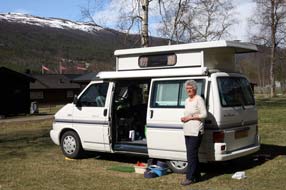|
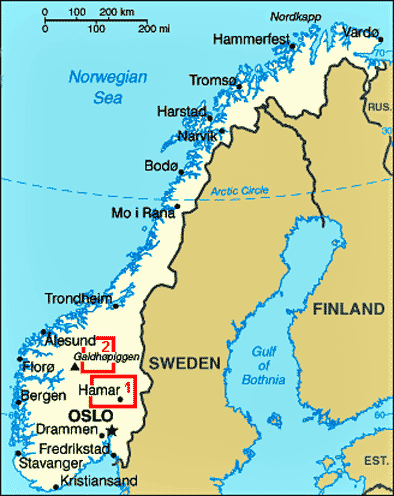 CAMPING
IN NORWAY 2014 - SE Norway and Lillehammer, Eastern Jotunheimen Mountains,
Gudbrandsdalen, Norway's National Day (17 May), Rondane and Dovrefjell National Parks: CAMPING
IN NORWAY 2014 - SE Norway and Lillehammer, Eastern Jotunheimen Mountains,
Gudbrandsdalen, Norway's National Day (17 May), Rondane and Dovrefjell National Parks:
On a dreary wet morning, we left Oslo's eastern
suburbs to join the E6 highway, the road that would lead the length of the
country all the way up to Kirkenes in the far north. Before leaving home, we had
registered with the Norwegian Autopass system for automatic road tolls payment via
credit card, and had already passed through a number of toll 'bom-stasjons' around
the city. Still unsure of how the payment system worked, we pulled into an Esso
station with the 'Kr-service' sign; the fluently English-speaking lady helpfully
reassured us that the system worked efficiently, and we could check our
deductions statement on the
Autopass website.
Continuing north on E6 through dreary, rain-soaked forested lowland, we reached
the southern end of Lake Mjøsa, and here the road works began, 20 kms of new
road construction and tunnel boring along the lakeside, reducing E6 to a narrow,
mud-covered single-carriage-way with 50kph speed limit, with traffic crawling
amid heaps of rock debris and diggers. We eventually were able to turn off onto
Routes 3 and 25 to the small and unassuming town of Elverum.
|
Click on 2 highlighted areas of map
for
details of
SE Norway, Jotunheimen Mountains,
Rondane and Dovrefjell National Parks |
 |
Elverum and the Norwegian National Forestry
Museum: Elverum's claim to fame was that King Håkon VII and the
Norwegian government had fled here to this small town from Oslo after the German
invasion of April 1940, refusing to acquiesce in German demands for the
country's surrender to blatant aggression. A memorial in Elverum records this
event. Our reason for coming to this forestry town amid the timberlands of
Eastern Norway was to visit the Norske Skogs-museum (National Forestry Museum).
Having been so impressed with the Finnish equivalent forestry museum and
arboretum at Lusto near to Savonlinna, our disappointment here at the Norwegian
Forestry Museum was even more frustrating: the admission charge was excessive
(80 NOK even for seniors), displays were pretentious but superficial,
commentaries ill-informative, and the small, poorly labelled arboretum scarcely worth
bothering with in pouring rain. All in all, the Norwegian National Forestry
Commission could
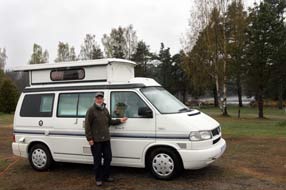 spend its public funding to better effect, and we told them so. spend its public funding to better effect, and we told them so.
Elverum Camping: having shopped
for provisions in Elverum's Co-op, we headed for Elverum Camping, a
long-established family-run campsite on the banks of the fast-flowing Glomma
River just south of the town. The owner welcomed us in fluent English, saying to
settle in and he would be there in 10 minutes; his helpful and hospitable manner
set an example which many other campsite owners could well follow. With a
nightly all-inclusive charge of 200 NOK including site-wide wi-fi internet,
luxurious standard of heated facilities, and beautiful riverside setting even in
pouring rain with the temperature bitterly cold, Elverum was an admirable site
(see left).
It rained all night and the following morning the air temperature was so cold
that the rain fell as sleet; for the first time in southern Scandinavia, we were
reduced to wearing full arctic gear for warmth for our day in camp with the
heater on all day. In full waterproofs Sheila took an exploratory walk along the river bank
searching for beaver lodges in the shallows by the river islands but found only gnawed
birch trunks. Despite the
wretchedly inhospitable weather, Elverum Camping will probably not be bettered
during our travels around Norway and fully worthy of our highest rating (Photo 1 - Elverum Camping).
Norwegian National Railway Museum at Hamar:
we left Elverum on a gloomy, wet
and bitterly cold morning with freshly fallen snow lying in the forest edges as
we drove westwards to Hamar, an important railway junction on the shores of the
lengthy lake Mjøsa, which now hosts the Norsk Jernbane (National Railway) Museum.
The museum's role is to document Norway's railway history in the context of
Norwegian social development since the mid-19th century, and the extraordinary engineering feats
required both to build a railway infrastructure in Norway's ruggedly mountainous
terrain and to maintain operating during the severe winter conditions. Railways
in Norway developed piecemeal starting in 1854 with the line northwards from
Oslo built by
British
engineers and navvies, with the transportation of timber and agricultural
produce being the main impetus. The rail line from Oslo to Trondheim via Røros
opened in 1880, with the route over the inhospitable Dovre
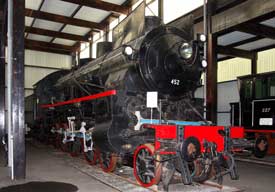 mountains not
completed until 1921. The south coast line to Kristiansand was not completed
until 1938 and the continuation to Stavanger only in 1944.The northern main
line was the last to open with the final stretch from Fauske to Bodø not opening
until 1962; parts of the line's civil engineering construction was by Russian
and Slavic slave labour under German WW2 occupation. The rail route to Bergen
over the central mountains was completed in 1909 with the highest point of the
line at 1,222m, and the extension from Myrdal at 866m down to sea level at Flåm
on the Sognfjord was opened in 1941. These lines served to develope the
burgeoning ski trade and tourist industry. mountains not
completed until 1921. The south coast line to Kristiansand was not completed
until 1938 and the continuation to Stavanger only in 1944.The northern main
line was the last to open with the final stretch from Fauske to Bodø not opening
until 1962; parts of the line's civil engineering construction was by Russian
and Slavic slave labour under German WW2 occupation. The rail route to Bergen
over the central mountains was completed in 1909 with the highest point of the
line at 1,222m, and the extension from Myrdal at 866m down to sea level at Flåm
on the Sognfjord was opened in 1941. These lines served to develope the
burgeoning ski trade and tourist industry.
We were greeted at the
museum reception however with disappointing
news: the collection of steam locomotives was closed at this time of year and
museum restricted to a few displays with no reduction in the 80 NOK admission
charge.
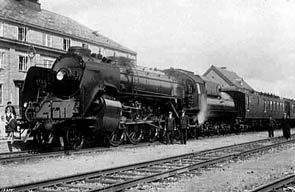 The
sadly inadequate display took all of 10 minutes, and the reception lady, clearly
sensing our frustration, offered to arrange for Svein Krogrud, one of the
museum's project advisers and himself a retired railway man, to show us the
modest collection of steam locomotives. The first of the engine sheds contained
an early electric loco used in the 1930s on the Oslo~Drammen line, and 2
mid-20th century express passenger steam locomotives (see left). The next shed
housed the pride of the small collection, one of five massive 2-8-4 4-cylinder
engines weighing 153 tons and built between 1935~41 by Krupps of Essen for
hauling passenger trains on the Trondheim line over the treacherous Dovre
Mountains, hence they were called the Dovre Gubben (Dovre Giants) (Photo
2 - Dovre Gubben steam locomotive). Reaching
speeds of 90kph, they were the heaviest locomotives on Norwegian State Railways
and continued in use until 1957 (see right). All of Norway's steam locomotives
were fired with coal imported from mines on Svalbard. Svein showed us up onto the
footplate of this mighty beast, where the poor fireman had a herculean task
stoking the enormous fire box, maintaining boiler pressure, and watching out for
signals or moose on the line ahead. He also said that engine crews routinely
carried hunting rifles to finish off any unfortunate moose struck by these
enormous monster engines! We were indeed grateful to Svein for his time in
showing us around the small locomotive collection at Hamar. The
sadly inadequate display took all of 10 minutes, and the reception lady, clearly
sensing our frustration, offered to arrange for Svein Krogrud, one of the
museum's project advisers and himself a retired railway man, to show us the
modest collection of steam locomotives. The first of the engine sheds contained
an early electric loco used in the 1930s on the Oslo~Drammen line, and 2
mid-20th century express passenger steam locomotives (see left). The next shed
housed the pride of the small collection, one of five massive 2-8-4 4-cylinder
engines weighing 153 tons and built between 1935~41 by Krupps of Essen for
hauling passenger trains on the Trondheim line over the treacherous Dovre
Mountains, hence they were called the Dovre Gubben (Dovre Giants) (Photo
2 - Dovre Gubben steam locomotive). Reaching
speeds of 90kph, they were the heaviest locomotives on Norwegian State Railways
and continued in use until 1957 (see right). All of Norway's steam locomotives
were fired with coal imported from mines on Svalbard. Svein showed us up onto the
footplate of this mighty beast, where the poor fireman had a herculean task
stoking the enormous fire box, maintaining boiler pressure, and watching out for
signals or moose on the line ahead. He also said that engine crews routinely
carried hunting rifles to finish off any unfortunate moose struck by these
enormous monster engines! We were indeed grateful to Svein for his time in
showing us around the small locomotive collection at Hamar.
Norway's Museum of Road Building and Tunnel
Construction at Hunderfossen:
continuing north alongside Lake Mjøsa
on E6 towards Lillehammer, we turned off on a minor road which climbed through
pine woods to reach Hunderfossen Camping, an over-pretentious but soulless, over-expensive
campsite set alongside the main Trondheim railway line where, unlike the steam
monsters seen at the railway museum, modern electric rail-cars glided past.
After a cheerlessly wet and chill night, the rain stopped but low cloud still
clung to the surrounding hills with streaks of snow still
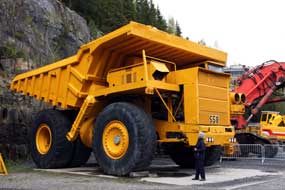 evident on the slopes; but at least the forecast showed improving weather over the coming days. Our
first stop this morning was the Norsk Vegmuseum (Museum of Road Construction) just along the lane, run by the Statens Vegvesen (State Road Authority). This
tells the story of both constructing the road network in Norway's challenging
terrain and maintaining it over winter. Uphill on the craggy fellside, the
Fjellsprengnings-museum (Rock-blasting Museum) is a 240m section of road tunnel
giving insight into the construction of road tunnels through Norwegian
mountains. And more to the point, the museum was free-entry. But disappointment
again: the museums were only open at weekends in May. We could walk around the
outdoor displays on a trail through the pine woods under the towering cliffs of
the craggy fellside, but there was little to see other than a few pieces of road
building or maintenance machinery and mini-skansen of road-associated buildings.
We walked the circuit anyway since the natural forest floor was just beginning
to come alive again after the winter snows with a covering of lingonberries in
tiny bud and bilberries with fresh green new leaf and globular pink early flowers. The
track-way circled back higher up the fellside with displays of modern
snow-clearing equipment, monster dumper-trucks (see left) and the portal of the
tunnel-building simulation of the Rock-blasting Museum (Photo
3 - Museum of Tunnel Construction). It was all locked up and
we could only peer through the door panels; mis-timing our visit had cost us the
opportunity to get a better understanding of tunnel construction, when we should
be using so many road-tunnels during our travels around Norway. evident on the slopes; but at least the forecast showed improving weather over the coming days. Our
first stop this morning was the Norsk Vegmuseum (Museum of Road Construction) just along the lane, run by the Statens Vegvesen (State Road Authority). This
tells the story of both constructing the road network in Norway's challenging
terrain and maintaining it over winter. Uphill on the craggy fellside, the
Fjellsprengnings-museum (Rock-blasting Museum) is a 240m section of road tunnel
giving insight into the construction of road tunnels through Norwegian
mountains. And more to the point, the museum was free-entry. But disappointment
again: the museums were only open at weekends in May. We could walk around the
outdoor displays on a trail through the pine woods under the towering cliffs of
the craggy fellside, but there was little to see other than a few pieces of road
building or maintenance machinery and mini-skansen of road-associated buildings.
We walked the circuit anyway since the natural forest floor was just beginning
to come alive again after the winter snows with a covering of lingonberries in
tiny bud and bilberries with fresh green new leaf and globular pink early flowers. The
track-way circled back higher up the fellside with displays of modern
snow-clearing equipment, monster dumper-trucks (see left) and the portal of the
tunnel-building simulation of the Rock-blasting Museum (Photo
3 - Museum of Tunnel Construction). It was all locked up and
we could only peer through the door panels; mis-timing our visit had cost us the
opportunity to get a better understanding of tunnel construction, when we should
be using so many road-tunnels during our travels around Norway.
So pleasing have been the flora and fauna which we
have photographed during these
2 weeks, that we have included a separate photo-gallery of the
wild flora and fauna of SE Norway and the mountains of Jotunheimen and
Dovrefjell.
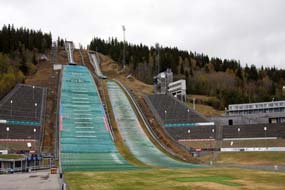 Lillehammer's 1994 Winter Olympics Ski-Jump: rejoining E6 back to Lillehammer, there was little reason for turning off into the town
other than to investigate the giant ski-jump which was visible above the town
for miles around. Lillehammer is one of Norway's foremost ski-resorts, and won
its bid to host the 1994 Winter Olympics. The Norwegian government invested a
massive 2 billion kroner in sporting facilities and infrastructure: ski-jumps,
ski- and bob-sleigh runs on the hill slopes above the town, with stadium and
chair-lifts, all of which remain in use today. From the TIC by the railway
station, we established the best route to approach the ski-jump and wound our way
uncertainly up the steep hillside to the foot of the enormous jump which Lillehammer's 1994 Winter Olympics Ski-Jump: rejoining E6 back to Lillehammer, there was little reason for turning off into the town
other than to investigate the giant ski-jump which was visible above the town
for miles around. Lillehammer is one of Norway's foremost ski-resorts, and won
its bid to host the 1994 Winter Olympics. The Norwegian government invested a
massive 2 billion kroner in sporting facilities and infrastructure: ski-jumps,
ski- and bob-sleigh runs on the hill slopes above the town, with stadium and
chair-lifts, all of which remain in use today. From the TIC by the railway
station, we established the best route to approach the ski-jump and wound our way
uncertainly up the steep hillside to the foot of the enormous jump which
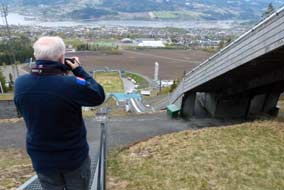 careered down the slopes above. The lane continued uphill to the huge
landing area at the foot of the ski-jump. The main ski-jump drops 136m with a landing-slope angle of 37.5°; the speed on take-off is a terrifying 86 mph, and
the 1994 gold medallist's longest leap was an astonishing 104m. We walked up to
the perimeter overlooking the landing area, giving us a clear view looking
straight up the entire length of the jump (see right) (Photo
4 - Lillehammer ski-jump). The incredibly impressive setting had been surrounded by
seating for 5,000 spectators, and the scene of the opening
ceremony with the Olympic Flame tower at the foot of the jump. With even more
uncertainty, we began the zigzagging lane up the increasingly steep hillside to
reach the jump-tower at the top of the slope. After series of hair-pins, an
unsurfaced lane lined with residual snow branched into murky pine forest. Here
a path led down from the parking area to what seemed a precipice at the
ski-jump's top with the tower from which competitors launched themselves into
space. From here we had a breath-taking panoramic view down the length of the
ski-jump course, with the town of Lillehammer spread out below alongside Lake Mjøsa
with snow-flecked hills rising beyond (see left) (Photo
5 - View from the top - LIllehammer ski-jump). It was nerve-wracking enough just standing
here looking down the precipitous slope; one simply could not imagine the
adrenaline-soaked feelings of skiers waiting to launch themselves
from the terrifying height of the tower. Our visit to the Lillehammer Olympic
ski-jump had been another first on our travels, the experience of which raised
our admiration for the sheer bravado of ski-jumpers. careered down the slopes above. The lane continued uphill to the huge
landing area at the foot of the ski-jump. The main ski-jump drops 136m with a landing-slope angle of 37.5°; the speed on take-off is a terrifying 86 mph, and
the 1994 gold medallist's longest leap was an astonishing 104m. We walked up to
the perimeter overlooking the landing area, giving us a clear view looking
straight up the entire length of the jump (see right) (Photo
4 - Lillehammer ski-jump). The incredibly impressive setting had been surrounded by
seating for 5,000 spectators, and the scene of the opening
ceremony with the Olympic Flame tower at the foot of the jump. With even more
uncertainty, we began the zigzagging lane up the increasingly steep hillside to
reach the jump-tower at the top of the slope. After series of hair-pins, an
unsurfaced lane lined with residual snow branched into murky pine forest. Here
a path led down from the parking area to what seemed a precipice at the
ski-jump's top with the tower from which competitors launched themselves into
space. From here we had a breath-taking panoramic view down the length of the
ski-jump course, with the town of Lillehammer spread out below alongside Lake Mjøsa
with snow-flecked hills rising beyond (see left) (Photo
5 - View from the top - LIllehammer ski-jump). It was nerve-wracking enough just standing
here looking down the precipitous slope; one simply could not imagine the
adrenaline-soaked feelings of skiers waiting to launch themselves
from the terrifying height of the tower. Our visit to the Lillehammer Olympic
ski-jump had been another first on our travels, the experience of which raised
our admiration for the sheer bravado of ski-jumpers.
Lake Mjøsa, Gjøvik and Route 33 to Fagernes
Camping:
our plan was to camp that night on the western shore of Lake Mjøsa but
Sveastrand Camping was clearly an enormous holiday-camp jam-packed full with
wall-to-wall static caravans, spilling over into the lake-side area allegedly
reserved for visitors; in summer this place would be sheer bedlam. We managed to
find a secluded area overlooking Lake Mjøsa (see right), and the following morning with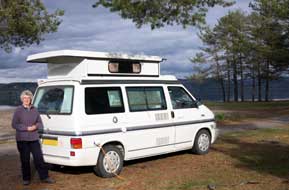 the
air warmer and not a breath of wind, a hazy sun lit the hills on the far side of
the lake with a small church reflected in the still water. Through
the small industrial town of Gjøvik, we turned westwards onto the quiet Route
33, gaining height gradually into forested rolling hill-farming countryside.
Snow still lined the north-facing shaded side of the road under pines, while
wood anemones covered the verges on the sunlit side. the
air warmer and not a breath of wind, a hazy sun lit the hills on the far side of
the lake with a small church reflected in the still water. Through
the small industrial town of Gjøvik, we turned westwards onto the quiet Route
33, gaining height gradually into forested rolling hill-farming countryside.
Snow still lined the north-facing shaded side of the road under pines, while
wood anemones covered the verges on the sunlit side.
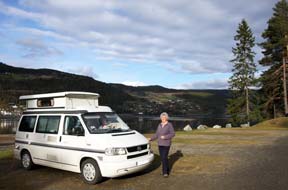 The road descended into a
broad lake-filled valley just beyond the small settlement of Dokka, and hazy
sunshine heightened the contrasting greens of the mixed pine and birch woods
covering the side hills: the glum, dark of the pines and the fresh pale green of
the birches' new leaf. Beyond Etnadalen with its fast-flowing white-water river,
the road climbed more steeply on sweeping narrow bends with increasing amounts
of snow and frozen, snow-bound lakes. Over the watershed of this shoulder of
hills, we began the long descent into the lovely valley of Aurdalen and the
junction with Route 16, the main Oslo~Bergen road, which continued high along
the valley side. Rounding the end of Strondafjorden, we reached Fagernes and
pulled into the lakeside campsite. Their website claimed that 'the most idyllic
spots were reserved for visitors', and it was true: at the far end we found a
peaceful, secluded corner terraced into the wooded hillside and overlooking the
lake (see left). The girl on reception was insistently helpful sorting out password for the
site-wide wi-fi, the setting was indeed idyllic, and facilities first class with
well-equipped kitchen and beautifully furnished common room; the only down-side
was cost at 250 NOK but we negotiated an inclusive price for the luxurious showers
(usually extra), and enjoyed a productive day in camp at this worthy site. The road descended into a
broad lake-filled valley just beyond the small settlement of Dokka, and hazy
sunshine heightened the contrasting greens of the mixed pine and birch woods
covering the side hills: the glum, dark of the pines and the fresh pale green of
the birches' new leaf. Beyond Etnadalen with its fast-flowing white-water river,
the road climbed more steeply on sweeping narrow bends with increasing amounts
of snow and frozen, snow-bound lakes. Over the watershed of this shoulder of
hills, we began the long descent into the lovely valley of Aurdalen and the
junction with Route 16, the main Oslo~Bergen road, which continued high along
the valley side. Rounding the end of Strondafjorden, we reached Fagernes and
pulled into the lakeside campsite. Their website claimed that 'the most idyllic
spots were reserved for visitors', and it was true: at the far end we found a
peaceful, secluded corner terraced into the wooded hillside and overlooking the
lake (see left). The girl on reception was insistently helpful sorting out password for the
site-wide wi-fi, the setting was indeed idyllic, and facilities first class with
well-equipped kitchen and beautifully furnished common room; the only down-side
was cost at 250 NOK but we negotiated an inclusive price for the luxurious showers
(usually extra), and enjoyed a productive day in camp at this worthy site.
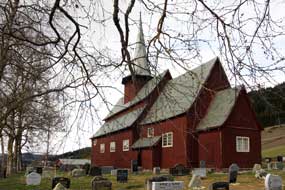 The Valdresflye pass (Route 51) over the
eastern shoulder of the Jotunheimen Mountains: our onward route from Fagernes would take us over the 4,500 feet high Valdresflye pass (Route 51) which
crosses the eastern shoulder of the Jotunheimen Mountains. See the Valdresflye National Tourist Road web site. We were however very
uncertain as to the amounts of snow and road conditions this early in the year.
Norway's road conditions telephone helpline (175) gave commendably helpful
advice in good English: the road was still closed overnight, but should be
passable without problems during the daytime. The trusted
Norwegian Meteorological Institute
forecast a window of fine weather for Gjendesheim across the Valdresflye plateau,
but with temperatures of -5°C even during the daytime! Fagernes was another of
those unpretentious small towns which provided a first class tourist information
service: the TIC offered a veritable library of useful brochures covering not
only the local area but northward to Trondheim and beyond. We also got
invaluable details of the state of the Valdresflye pass and what to expect; it
was clear that, despite the road being kept open, the amount of snow lining the
road at this altitude was still formidable. Although better informed now, it was
with some trepidation that we left Fagernes to begin the crossing of
Valdresflye. The Valdresflye pass (Route 51) over the
eastern shoulder of the Jotunheimen Mountains: our onward route from Fagernes would take us over the 4,500 feet high Valdresflye pass (Route 51) which
crosses the eastern shoulder of the Jotunheimen Mountains. See the Valdresflye National Tourist Road web site. We were however very
uncertain as to the amounts of snow and road conditions this early in the year.
Norway's road conditions telephone helpline (175) gave commendably helpful
advice in good English: the road was still closed overnight, but should be
passable without problems during the daytime. The trusted
Norwegian Meteorological Institute
forecast a window of fine weather for Gjendesheim across the Valdresflye plateau,
but with temperatures of -5°C even during the daytime! Fagernes was another of
those unpretentious small towns which provided a first class tourist information
service: the TIC offered a veritable library of useful brochures covering not
only the local area but northward to Trondheim and beyond. We also got
invaluable details of the state of the Valdresflye pass and what to expect; it
was clear that, despite the road being kept open, the amount of snow lining the
road at this altitude was still formidable. Although better informed now, it was
with some trepidation that we left Fagernes to begin the crossing of
Valdresflye.
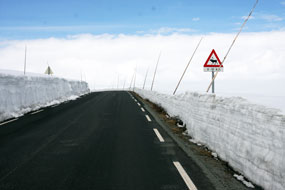 Hegge Stave Church: scattered
hill-farms dotted the hillsides lining the lower valley where the surface of
lakes, even at this low altitude, were still partly frozen. At the northern end
of the farming settlement of Heggenes, we paused to walk up to Hegge Stavkirke
(see right). Hegge stave church was built around 1281, the
capitals of its 8 columns were carved with faces, one having just one eye
resembling Odin as if the pagan gods were condemned to the demeaning role of
supporting the new Christian church's roof. The carved altarpiece dates from
1782, and the story goes that 4 farmers from Hegge, after trading cattle in
Gudbrandsdalen, were lost in a storm on their return through the mountains. They
swore that if they returned home safely, each would donate the value of a cow
for a new altarpiece. They kept their promise and a new altarpiece was ordered;
bringing it home however on a sledge in the winter snow, they lost the figure of
Judas which was found the following summer its paintwork faded (Photo
6 - Hegge Stave Church). Hegge Stave Church: scattered
hill-farms dotted the hillsides lining the lower valley where the surface of
lakes, even at this low altitude, were still partly frozen. At the northern end
of the farming settlement of Heggenes, we paused to walk up to Hegge Stavkirke
(see right). Hegge stave church was built around 1281, the
capitals of its 8 columns were carved with faces, one having just one eye
resembling Odin as if the pagan gods were condemned to the demeaning role of
supporting the new Christian church's roof. The carved altarpiece dates from
1782, and the story goes that 4 farmers from Hegge, after trading cattle in
Gudbrandsdalen, were lost in a storm on their return through the mountains. They
swore that if they returned home safely, each would donate the value of a cow
for a new altarpiece. They kept their promise and a new altarpiece was ordered;
bringing it home however on a sledge in the winter snow, they lost the figure of
Judas which was found the following summer its paintwork faded (Photo
6 - Hegge Stave Church).
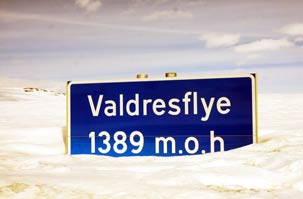 Crossing the snow-bound
Valdresflye:
reaching the ski resort of Beitostølen the sky cleared to give bright warming
sunshine, and with the weather now looking good these were ideal conditions to
continue over the highest part of the Valdresflye plateau. The road now gained
height becoming a tarmac mini-canyon enclosed within snow-banks 2~3m high on
both sides, with snow-poles poking out above the snow-banks (see above left), pines and birches
on the hills standing out among surrounding snow fields, and ahead the 1608m
peak of Bitihorn towering over the road (Photo
7 - Valdresflye snow-banks). Maintaining this highway and keeping it Crossing the snow-bound
Valdresflye:
reaching the ski resort of Beitostølen the sky cleared to give bright warming
sunshine, and with the weather now looking good these were ideal conditions to
continue over the highest part of the Valdresflye plateau. The road now gained
height becoming a tarmac mini-canyon enclosed within snow-banks 2~3m high on
both sides, with snow-poles poking out above the snow-banks (see above left), pines and birches
on the hills standing out among surrounding snow fields, and ahead the 1608m
peak of Bitihorn towering over the road (Photo
7 - Valdresflye snow-banks). Maintaining this highway and keeping it
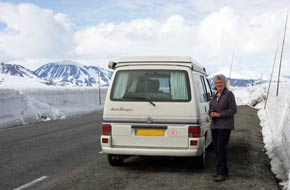 open to traffic from April~October must be a nightmare, with constantly changing weather conditions and still so much
residual snow. The tarmac ribbon of road carved through
snow-banks wound around sweeping curves to a high point and began the descent to
the inn at the eastern end of Lake Bygdin; but despite the lake's huge length,
today it was totally frozen and indistinguishable amid the covering of snow
fields (Photo
8 - White-out at frozen Lake Bygdin. At Bygdinheimen, the road crossed a narrow bridge over Bygdin's
outflow-river, and now steadily gained a further 300m of height up onto the highest
part of the Valdresflye plateau. Within the enclosing 2m high walls of snow, the
road advanced in a straight undulating line, the tarmac remarkably now dry
under the bright warming sun; we had certainly chosen the ideal conditions to
make the crossing of the Valdresflye plateau. For us these were unprecedented
driving conditions, but could see little to either side, distant views
restricted by the vertical walls of snow-banks. The gradient eased as open to traffic from April~October must be a nightmare, with constantly changing weather conditions and still so much
residual snow. The tarmac ribbon of road carved through
snow-banks wound around sweeping curves to a high point and began the descent to
the inn at the eastern end of Lake Bygdin; but despite the lake's huge length,
today it was totally frozen and indistinguishable amid the covering of snow
fields (Photo
8 - White-out at frozen Lake Bygdin. At Bygdinheimen, the road crossed a narrow bridge over Bygdin's
outflow-river, and now steadily gained a further 300m of height up onto the highest
part of the Valdresflye plateau. Within the enclosing 2m high walls of snow, the
road advanced in a straight undulating line, the tarmac remarkably now dry
under the bright warming sun; we had certainly chosen the ideal conditions to
make the crossing of the Valdresflye plateau. For us these were unprecedented
driving conditions, but could see little to either side, distant views
restricted by the vertical walls of snow-banks. The gradient eased as the narrow
ribbon of road levelled onto the plateau top to approach the highest point at
1,389m (4,555 feet), where the sign marking the pass' high point was half buried
in a snow bank (see above right) (Photo
9 - Snow-banks Valdresflye plateau). the narrow
ribbon of road levelled onto the plateau top to approach the highest point at
1,389m (4,555 feet), where the sign marking the pass' high point was half buried
in a snow bank (see above right) (Photo
9 - Snow-banks Valdresflye plateau).
A parking area enabled us to stop and admire
the spectacular mountain views ahead across snow-fields towards the northern
Jotunheimen peaks (see above left) (Photo
10 - Jotunheimen Mountains from Valdresflye plateau). The distant bulky mass of snow-covered Bessfjell dominated
the northern skyline, but from here it was impossible to distinguish the
so-called Peer Gynt's Ridge
(Besseggen). We clambered up onto
the snow fields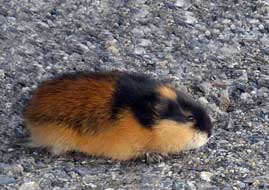 which stretched away into the distance marked with ski trails
with the afternoon sun glistening on the shiny crust of the snow (see right) (Photo
11 - Jotunheimen snow-fields); it was a truly
magnificent and awe-inspiring vista. As we walked back along the road to where
George was parked, we could see tiny buff and black furry rodents scuttling
along the side-gulley at the foot of the snow-bank, identified as lemmings (see
left).
Norway's national rodent's reputation for mass suicides is entirely
mythological: in 'good lemming years', population increases cause food shortage
resulting in mass migrations across mountainous terrain and fjords; pressure
from the rear of these migrating masses of rodents simply forces the leading
animals to fall to their deaths from crags or cliffs or drown in fjord
waters. And here they were scurrying along the road-side gulley right at our
feet
(Photo
12 - Norwegian Lemming). which stretched away into the distance marked with ski trails
with the afternoon sun glistening on the shiny crust of the snow (see right) (Photo
11 - Jotunheimen snow-fields); it was a truly
magnificent and awe-inspiring vista. As we walked back along the road to where
George was parked, we could see tiny buff and black furry rodents scuttling
along the side-gulley at the foot of the snow-bank, identified as lemmings (see
left).
Norway's national rodent's reputation for mass suicides is entirely
mythological: in 'good lemming years', population increases cause food shortage
resulting in mass migrations across mountainous terrain and fjords; pressure
from the rear of these migrating masses of rodents simply forces the leading
animals to fall to their deaths from crags or cliffs or drown in fjord
waters. And here they were scurrying along the road-side gulley right at our
feet
(Photo
12 - Norwegian Lemming).
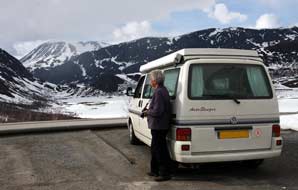 A
hospitable campsite, the
Jotunheimen Feriesenter:
starting down the descent from the plateau in long sweeping curves,
we reached a
view point looking along the shapely length of the Knutshö crested ridge-line
(Photo
13 - Knutshö crested ridge-line) and
from here the distinctive outline of the
Besseggen ridge was more clearly
visible, with frozen, snow-covered Gjende Lake just hidden behind the closer low
hill of Gjendeshö (see right)
(Photo
14 - Besseggen (Peer Gynt's Ridge)). Across the bridge over the outflow-river from Lake Gjende, we
continued ahead under the snow and wispy birch covered lower
eastern slopes of Bessfjell alongside the totally frozen lake of Øvre Sjosalsvatnet,
losing height
down into Sjodalen alongside the fast-flowing Sjoa A
hospitable campsite, the
Jotunheimen Feriesenter:
starting down the descent from the plateau in long sweeping curves,
we reached a
view point looking along the shapely length of the Knutshö crested ridge-line
(Photo
13 - Knutshö crested ridge-line) and
from here the distinctive outline of the
Besseggen ridge was more clearly
visible, with frozen, snow-covered Gjende Lake just hidden behind the closer low
hill of Gjendeshö (see right)
(Photo
14 - Besseggen (Peer Gynt's Ridge)). Across the bridge over the outflow-river from Lake Gjende, we
continued ahead under the snow and wispy birch covered lower
eastern slopes of Bessfjell alongside the totally frozen lake of Øvre Sjosalsvatnet,
losing height
down into Sjodalen alongside the fast-flowing Sjoa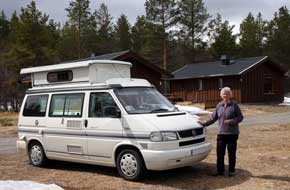 river. Below the tree where
pines covered the lower slopes, we turned onto Route 257 at the road junction of
Randsverk and 2kms further reached tonight's campsite Jotunheimen Feriesenter.
Here we were welcomed by the delightfully hospitable Petrita
who has kept the campsite single-handedly for 27 years, and who insisted on
helping us find solid ground where the snow had recently melted (Photo
15 - Jotunheimen Feriesenter-Camping). The setting was
magnificent (see left) looking up at snow-covered mountains amid the pine woods of the
upper Sjoa valley on the banks of the fast-flowing Sjoa river whose source is
Lake Gjende high in the Jotunheimen, and we had this this beautifully maintained
campsite to ourselves as our base for the next 3 days
(Photo
16 - Fast-flowing Sjoa River). river. Below the tree where
pines covered the lower slopes, we turned onto Route 257 at the road junction of
Randsverk and 2kms further reached tonight's campsite Jotunheimen Feriesenter.
Here we were welcomed by the delightfully hospitable Petrita
who has kept the campsite single-handedly for 27 years, and who insisted on
helping us find solid ground where the snow had recently melted (Photo
15 - Jotunheimen Feriesenter-Camping). The setting was
magnificent (see left) looking up at snow-covered mountains amid the pine woods of the
upper Sjoa valley on the banks of the fast-flowing Sjoa river whose source is
Lake Gjende high in the Jotunheimen, and we had this this beautifully maintained
campsite to ourselves as our base for the next 3 days
(Photo
16 - Fast-flowing Sjoa River).
A nostalgic day up at Gjendesheim by frozen Lake
Gjende in the Eastern Jotunheimen Mountains: after a bitterly cold night with the chill northerly wind
turning rain to sleet, we woke to a weak sun which soon brightened to give
perfect weather for our day up at Gjendesheim; in readiness for the anticipated
conditions in the higher mountains, we dressed in multi-layered full arctic
gear. The distant snow-covered peaks glistened in bright morning sunshine
as we began the long re-ascent of Sjodalen, pausing to photograph the
snow-covered, frozen Lake
Sjosalsvatnet; it was a glorious
scene worthy of our next Christmas card
(Photo
17 - Frozen Lake Sjosalsvatnet). We turned off up to the mountain hut of
 Gjendesheim, closed at this time of year, at the eastern end of Gjende set high
above the frozen, snow-covered outflow of the lake, and rounding a shoulder of
the hillside, spread out ahead was the glorious spectacle of Gjende's full
panorama (see right): the length of the lake was totally frozen and snow-covered, and
surrounded by magnificent mountains enclosed on the northern side by the
bulky massif of Veslfjell and the crest of Besseggen just visible at the far end.
The southern side of the lake was enclosed by the low summit of Gjendeshö and
peeping out above this the higher peaks of the
Knutshö crested ridge. In the distance at the far
end of Lake Gjende, a spectacular array of the central Jotunheimen's
snow-covered peaks glistened in the bright sunshine. At the foot of these
mountains would be the distant mountain huts of Gjendebu and Memurubu, 2 of the
huts used by Paul on his 1968 Jotunheimen expedition (Photo
18 - Frozen Lake Gjende's Jotunheimen panorama). Gjendesheim, closed at this time of year, at the eastern end of Gjende set high
above the frozen, snow-covered outflow of the lake, and rounding a shoulder of
the hillside, spread out ahead was the glorious spectacle of Gjende's full
panorama (see right): the length of the lake was totally frozen and snow-covered, and
surrounded by magnificent mountains enclosed on the northern side by the
bulky massif of Veslfjell and the crest of Besseggen just visible at the far end.
The southern side of the lake was enclosed by the low summit of Gjendeshö and
peeping out above this the higher peaks of the
Knutshö crested ridge. In the distance at the far
end of Lake Gjende, a spectacular array of the central Jotunheimen's
snow-covered peaks glistened in the bright sunshine. At the foot of these
mountains would be the distant mountain huts of Gjendebu and Memurubu, 2 of the
huts used by Paul on his 1968 Jotunheimen expedition (Photo
18 - Frozen Lake Gjende's Jotunheimen panorama).
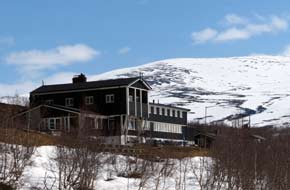 Despite our concerns about the weather, there
was not even a hint of the arctic north wind and the sunshine was quite warm
lighting the frozen surface of the lake. The 2 boats, which in summer run the
length of the lake to Gjendebu and Memurubu huts, were today ice-bound at the end
of the lake and surrounded by snow (Photo
19 - Ice-bound Gjende boats). There was not another soul in sight and the
only sound was that of the few birds flitting around. We clambered up onto the
now dry fellside where snow had recently melted. Paul's eyes were drawn to the
start of the footpath way-marked with the familiar DNT red Ts painted on rocks
and signed for Besseggi and the distant Despite our concerns about the weather, there
was not even a hint of the arctic north wind and the sunshine was quite warm
lighting the frozen surface of the lake. The 2 boats, which in summer run the
length of the lake to Gjendebu and Memurubu huts, were today ice-bound at the end
of the lake and surrounded by snow (Photo
19 - Ice-bound Gjende boats). There was not another soul in sight and the
only sound was that of the few birds flitting around. We clambered up onto the
now dry fellside where snow had recently melted. Paul's eyes were drawn to the
start of the footpath way-marked with the familiar DNT red Ts painted on rocks
and signed for Besseggi and the distant
 Glitterheim, the hut used in 1968 prior to the climb of Norway's highest mountain, Glittertind. Sheila however, ever the
botanist, had spotted another gem: the curious but spectacular lone Spring Pasque Flowers dotted amid the snow-crushed fellside grass
(see left) (Photo
20 - Spring Pasque Flower). While she
photographed these, Paul focussed his camera on the mountainous spectacle
looking along the lake (Photo
21 - Lake Gjende's mountain spectacular). For him this was a nostalgic moment: never could he have
believed that, after traversing the Besseggi ridge in 1968 and descending to
this very point to stay at Gjendesheim hut, he would be standing here again 46
years later (Photo
22 - Descending to Gjendesheim hut). It was also a nostalgic pleasure using the 1:100k maps first used
in 1968. Glitterheim, the hut used in 1968 prior to the climb of Norway's highest mountain, Glittertind. Sheila however, ever the
botanist, had spotted another gem: the curious but spectacular lone Spring Pasque Flowers dotted amid the snow-crushed fellside grass
(see left) (Photo
20 - Spring Pasque Flower). While she
photographed these, Paul focussed his camera on the mountainous spectacle
looking along the lake (Photo
21 - Lake Gjende's mountain spectacular). For him this was a nostalgic moment: never could he have
believed that, after traversing the Besseggi ridge in 1968 and descending to
this very point to stay at Gjendesheim hut, he would be standing here again 46
years later (Photo
22 - Descending to Gjendesheim hut). It was also a nostalgic pleasure using the 1:100k maps first used
in 1968.
We walked over to the closed and deserted
Gjendesheim hut (Photo
23 - Gjendesheim mountain hut), and from its partially snow-coved terrace took further photos
looking along the length of the lake and its enclosing array of peaks (Photo
24 - Lake Gjende from terrace of Gjendesheim hut) - another
nostalgic moment standing here by the hut at which he and his friend Andrew
had stayed in 1968 before going on to climb Glittertind and Galdhøpiggen (see
right); see the
gallery of photos from
Paul's
1968 Jotunheimen expedition.
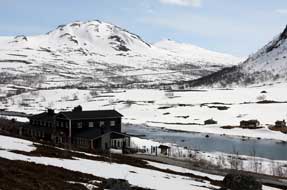 Climbing some way up the fellside path,
we were soon crossing patches of soft snow into which our boots sank, but the
awe-inspiring views from this higher vantage point looking along the length of
Lake Gjende made the slog spectacularly worthwhile (Photo
25 - Snow-covered Besseggen fells). Climbing some way up the fellside path,
we were soon crossing patches of soft snow into which our boots sank, but the
awe-inspiring views from this higher vantage point looking along the length of
Lake Gjende made the slog spectacularly worthwhile (Photo
25 - Snow-covered Besseggen fells).
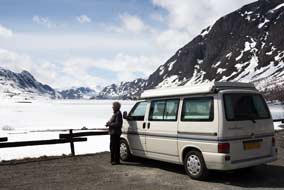 Whereas in summer the lake
when viewed from above would have been its characteristic vivid turquoise colour
from all the glacial sediment from its sources, today it was flat white from its
ice and snow crusting. Returning down to George parked by the hut (Photo
26 - Farewell to the Jotunheimen), Paul said his
final farewell to Gjende and the Gjendesheim hut (see left), and we set off with feelings of
exhilaration at having achieved the re-visit in such glorious weather
conditions, to begin the long descent down Sjodalen. Back down below the
tree-line, first the wispy birch then the pines, we returned to
Jotunheimen Feriesenter to set up
camp again on the trim-looking turf under the pines where Petrita the hard-working
owner had been
working all day raking up tree debris and pine needles. That evening as the
sun dipped below the hillside and the sky still clear, the temperature again
dropped severely. Whereas in summer the lake
when viewed from above would have been its characteristic vivid turquoise colour
from all the glacial sediment from its sources, today it was flat white from its
ice and snow crusting. Returning down to George parked by the hut (Photo
26 - Farewell to the Jotunheimen), Paul said his
final farewell to Gjende and the Gjendesheim hut (see left), and we set off with feelings of
exhilaration at having achieved the re-visit in such glorious weather
conditions, to begin the long descent down Sjodalen. Back down below the
tree-line, first the wispy birch then the pines, we returned to
Jotunheimen Feriesenter to set up
camp again on the trim-looking turf under the pines where Petrita the hard-working
owner had been
working all day raking up tree debris and pine needles. That evening as the
sun dipped below the hillside and the sky still clear, the temperature again
dropped severely.
Heidalen: the following morning, we began the long, winding descent of lower Sjodalen with
Route 257 perched on a shelf high above the river gorge way below and
spectacular fell-country rising on the far side of the valley. Altitude and
therefore
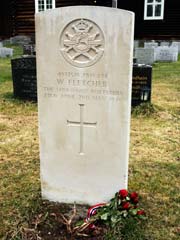 temperature make such a noticeable difference in the timing at which
the birches come into leaf in the early springtime. High up at Gjendesheim and
even here in the upper part of Sjodalen, birches were still in tight bud giving
the trees a bare wispy appearance; as we reached the lower Heidal valley, the birches covering the valley sides were just breaking into pale green
leaf whereas later in the day down in Gudbrandsdalen the trees were almost in full leaf. Up in the higher reaches
of Sjodalen, the opposite steep fell-sides showed clearly the distinctive
boundaries of the tree-line: rising up from the river gorge, the valley bottom
was filled with gloomy pines, which part way up gave way to wispy birches, and
beyond this the higher fell-tops were bare and still covered with snow. Route 257
dropped via hairpins to the long lower valley of Heidalen with hill-farms dotted
along the valley-sides and pastures along the broad valley floor. At Heidal, the
main village and service centre for the temperature make such a noticeable difference in the timing at which
the birches come into leaf in the early springtime. High up at Gjendesheim and
even here in the upper part of Sjodalen, birches were still in tight bud giving
the trees a bare wispy appearance; as we reached the lower Heidal valley, the birches covering the valley sides were just breaking into pale green
leaf whereas later in the day down in Gudbrandsdalen the trees were almost in full leaf. Up in the higher reaches
of Sjodalen, the opposite steep fell-sides showed clearly the distinctive
boundaries of the tree-line: rising up from the river gorge, the valley bottom
was filled with gloomy pines, which part way up gave way to wispy birches, and
beyond this the higher fell-tops were bare and still covered with snow. Route 257
dropped via hairpins to the long lower valley of Heidalen with hill-farms dotted
along the valley-sides and pastures along the broad valley floor. At Heidal, the
main village and service centre for the
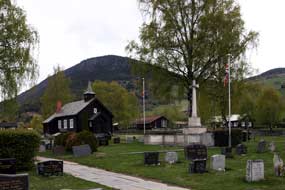 valley's farming communities with shops
and school, we parked by the wooden church where the graveyard gate had a
Commonwealth War Graves Commission plaque. A search of the
carefully tended graveyard eventually revealed among local graves a lone
distinctively shaped CWGC headstone of British soldier, Private W Fletcher of
the Sherwood Foresters (see right); he was part of a small British contingent, which along
with Norwegian troops had attempted to delay the German advance northwards after
the April 1940 invasion, and died of wounds here on 2 May 1940. We stood to pay
our respects at the lone grave of a man whose home in Notts was so far from this
beautiful Norwegian farming valley. valley's farming communities with shops
and school, we parked by the wooden church where the graveyard gate had a
Commonwealth War Graves Commission plaque. A search of the
carefully tended graveyard eventually revealed among local graves a lone
distinctively shaped CWGC headstone of British soldier, Private W Fletcher of
the Sherwood Foresters (see right); he was part of a small British contingent, which along
with Norwegian troops had attempted to delay the German advance northwards after
the April 1940 invasion, and died of wounds here on 2 May 1940. We stood to pay
our respects at the lone grave of a man whose home in Notts was so far from this
beautiful Norwegian farming valley.
Gudbrandsdalen: continuing down
valley above the spectacular gorges of the white-water Sjoa river, we re-joined
the E6 highway, here busy with speeding cars, heavy trucks and speed cameras and
turned south down the Gudbrandsdalen valley to the small town of Kvam. Here in
the churchyard a CWGC memorial and union flags honoured 54 British
soldiers killed in April~May 1940 in the bitter fighting around Kvam (see left), with a meagre and
ill-equipped British and Norwegian force trying to stem the superior armed
German advance north along Gudbrandsdalen (Photo
27 - CWGC memorial at Kvam). The names of these 54 men of the
Yorks and Lancs, Kings Own Light Infantry and Worcestershire Regiments were
inscribed on the cross of remembrance here at Kvam cemetery by the wooden parish
church. We again paid our respects before continuing our drive down E6 to keep
our appointment to visit
Ringebu Stave Church
30kms south.
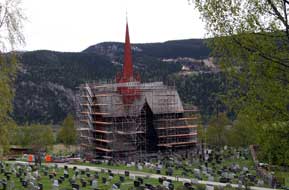 Ringebu Stave Church: just beyond
the modern village of Ringebu, a lane led steeply uphill to the huge wooden
stave church set high on a flat hill-top overlooking the valley. Norway
converted to Christianity around 1000 AD and during the medieval period some
1000 wooden stave churches were built. Ringebu Church, one of the largest of the
28 surviving stave churches, was built around 1220. The characteristic defining feature of Norwegian wooden stave-churches is the timber framework of vertical
posts (staves or stolpe) set into the ground on stone plinths which supports the
roof structure and around which the timber planking of the nave is attached; no
nails were used in the construction all joints being dove-tailed. Following the
Lutheran Reformation, Ringebu Church was rebuilt to its present cruciform shape
with its red-painted wooden tower in 1630, and in 1717 the church interior was
painted with Baroque decorations. The Ringebu Stave Church: just beyond
the modern village of Ringebu, a lane led steeply uphill to the huge wooden
stave church set high on a flat hill-top overlooking the valley. Norway
converted to Christianity around 1000 AD and during the medieval period some
1000 wooden stave churches were built. Ringebu Church, one of the largest of the
28 surviving stave churches, was built around 1220. The characteristic defining feature of Norwegian wooden stave-churches is the timber framework of vertical
posts (staves or stolpe) set into the ground on stone plinths which supports the
roof structure and around which the timber planking of the nave is attached; no
nails were used in the construction all joints being dove-tailed. Following the
Lutheran Reformation, Ringebu Church was rebuilt to its present cruciform shape
with its red-painted wooden tower in 1630, and in 1717 the church interior was
painted with Baroque decorations. The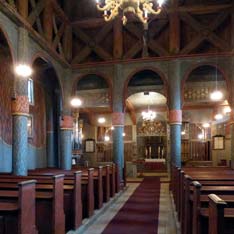 church continues in use today as Ringebu's
main parish church. church continues in use today as Ringebu's
main parish church.
Reaching the church, it was clear that major
restoration work was being carried out to replace timbers of the tower and spire
since the huge wooden structure was swathed in scaffolding (see left) (Photo
28 - Ringebu Stave Church). Although the church
was not officially open at this time of year, we had arranged a visit with the
verger, Mr Lars Smestadmoen, who gave us details of stave church construction
and the history of Ringebu Church. The vertical staves were certainly sturdy as
was the planking forming the nave walls. We managed to take photos of the gloomy
interior and of the ornately coloured Baroque altarpiece and pulpit (see below
left), and Sheila
was invited to play the new organ, built with the tone of a Baroque instrument
by a Swedish organ builder (Photo
29 - Ringebu Stave Church organ). We were very grateful to Mr Smestadmoen for arranging this special
visit for us; he continued with his work planting out the carefully tended
graveyard while we walked across to photograph the huge wooden church's exterior
despite the gloomy weather.
Hundorp Viking Age grave mounds:
having shopped for provisions in the Rimi supermarket in Ringebu village, we
drove back along E6 up Gudbrandsdal valley to Hunsdorp where, in the grounds of
a former farmstead now the Dale-Gudbrandsgård hotel, 6 Viking age burial mounds
and stone circle marking the
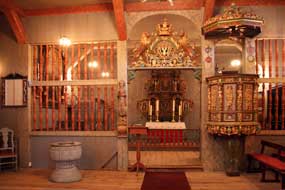 local Thing (Council) had been discovered. The
site had been farmed from time immemorial, the most renowned land-owner being a
Viking warrior-chieftain name Dale Gudbrand whose grave the best preserved of
the mounds is said to mark. He and his pals of the Hundorp Thing had been
unenthusiastically converted to Christianity in the early 11th century AD by
King Olav II Haraldson. St Olaf as he later became had rampaged through Central
Norway with proselytising zeal imposing the new religion by force or trickery on
the reluctant pagan farming folk who eventually sided with Olaf's enemy to
finish him off at the Battle of Sticklestad in 1030 AD; more of that in the next
edition. Back along E6 we found Frya Leir Camping; the place
was run by a friendly young Pole from Krakow who welcomed us for a night's stay
at the local Thing (Council) had been discovered. The
site had been farmed from time immemorial, the most renowned land-owner being a
Viking warrior-chieftain name Dale Gudbrand whose grave the best preserved of
the mounds is said to mark. He and his pals of the Hundorp Thing had been
unenthusiastically converted to Christianity in the early 11th century AD by
King Olav II Haraldson. St Olaf as he later became had rampaged through Central
Norway with proselytising zeal imposing the new religion by force or trickery on
the reluctant pagan farming folk who eventually sided with Olaf's enemy to
finish him off at the Battle of Sticklestad in 1030 AD; more of that in the next
edition. Back along E6 we found Frya Leir Camping; the place
was run by a friendly young Pole from Krakow who welcomed us for a night's stay
at the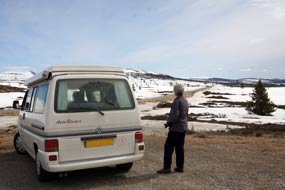 all-inclusive price of 200 NOK including site-wide-wi-fi. Daylight was beginning to linger
later and later now, and even in the early hours it never really became dark.
Our plan for the following day was to cross the high fell-land of Rondane
National Park, and given the uncertain snow conditions on Route 27, we again got
helpful advice from the national road conditions helpline 175: the road was
clear with no known problems. all-inclusive price of 200 NOK including site-wide-wi-fi. Daylight was beginning to linger
later and later now, and even in the early hours it never really became dark.
Our plan for the following day was to cross the high fell-land of Rondane
National Park, and given the uncertain snow conditions on Route 27, we again got
helpful advice from the national road conditions helpline 175: the road was
clear with no known problems.
Crossing the snow-covered Rondane National Park: turning from E6,
Route 27 immediately climbed steeply gaining significant height above
Gudbrandsdal valley floor; as the height increased, so the birches showed less
developed new leaf. As we passed through the small village of Venabygd
with its neat church perched high on the hill-side, the clouds began to break
and a bright sun shine through. Further height gain brought us above the tree
line as the road flattened onto the high snow-covered plateau top with superb
views to the
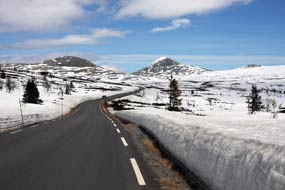 distant Rondane peaks. Beyond the large settlement of Venabu,
although the road was cleared of snow, banks of snow again lined each side. On a
bright morning, it was a superb setting with clear views across the snow-fields
of the Rondane's shapely mountains. Passing frozen lakes, we advanced through
the snow-banks across the highest reaches of the Rondane plateau, pausing
frequently for photos of the snowy wilderness and distant mountains (Photo
30 - Snow-covered Rondane plateau). Then began
the gradual descent on the far side of the plateau following the line of a
frozen, snow-covered water course down into a defile. Below the tree-line with
its wispy birches (Photo
31 - Descent from Rondane plateau), the final part of the descent dropped dramatically around a
hair-pin down towards the tiny hill-farming hamlet of Enden. Just above the4
road junction, we passed a bijou little campsite, Solhaug Camping, idyllically
perched on a flat grassy ledge overlooking a frozen lake and distant Rondane peaks. Beyond the large settlement of Venabu,
although the road was cleared of snow, banks of snow again lined each side. On a
bright morning, it was a superb setting with clear views across the snow-fields
of the Rondane's shapely mountains. Passing frozen lakes, we advanced through
the snow-banks across the highest reaches of the Rondane plateau, pausing
frequently for photos of the snowy wilderness and distant mountains (Photo
30 - Snow-covered Rondane plateau). Then began
the gradual descent on the far side of the plateau following the line of a
frozen, snow-covered water course down into a defile. Below the tree-line with
its wispy birches (Photo
31 - Descent from Rondane plateau), the final part of the descent dropped dramatically around a
hair-pin down towards the tiny hill-farming hamlet of Enden. Just above the4
road junction, we passed a bijou little campsite, Solhaug Camping, idyllically
perched on a flat grassy ledge overlooking a frozen lake and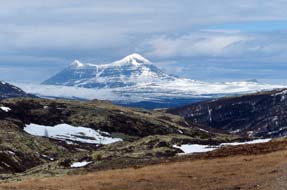 surrounded by pine
trees. It looked so perfect, we were tempted to stay; if ever we pass this way
again ... surrounded by pine
trees. It looked so perfect, we were tempted to stay; if ever we pass this way
again ...
Route 27 followed the river through pine woods
along the valley bottom, but the bright sun of earlier had now given way to
gloomy cloud obscuring what would have been the magnificent views of the distant
snow-covered Rondane peaks. Continuing down valley, the long road through
hill-farming pastures led eventually to the junction with Route 29 at Folldal.
The little town clustered around the road junction seemed an unnoteworthy place,
but we spotted a sign pointing to Folldal Gruver-Museum. Curiosity prevailed and
we followed the signs steeply uphill to end at what clearly had been a copper
mine. The mining museum, like the long-deceased mine, was closed this early in
the year, but we found a brochure which told a little of Folldal Gruva's
history: the mine had operated from 1748 until 1970 producing sulphur, zinc and
primarily copper, with a 35km ropeway to transport ore to the railway at Alvdal.
We saw a little light industry in the town outskirts, but mining had clearly
been Folldal's principal source of employment, as its crest with gold coloured
pick axe showed; with this now long gone, today it seemed a sad-looking little
place.
The mountain-inn at Kongsvoll: the
final 30kms along to re-join E6 at Hjerkinn was a long and tedious drive
particularly in gloomy weather. Before turning south on E6 to Dombås for
tonight's campsite, we diverted 12kms northwards to the former mountain-inn at
Kongsvoll, now a hotel which doubles as the Dovrefjell National Park Information
Centre. This section of E6 crosses the wild fell-land plateau of Dovrefjell
which in today's gloomily overcast conditions did indeed feel a bleak and
inhospitably exposed place, with snow-fencing to protect the road from winter
wind-driven snow drifts. The E6 ran across the high plateau paralleled by the
Trondheim railway line, and descended to the Kongsvoll inn near the tiny
station-halt on the railway. The road across Dovrefjell which continued past
Kongsvoll into the precipitous defile of Grivdalen had long existed as part of
the pilgrims' route towards St Olav's tomb at Trondheim. During the 18~19th
centuries as horse and carriage transport developed, staging-inns were leased by
the Crown to farmers at Kongsvoll, Hjerkinn and Fokstua to accommodate pilgrims
and travellers along the Gamle Kongeveg (Old
 King's Road). The current owner at Kongsvoll was a mine of information about Dovrefjell:
disappointingly she said
the footpath we had planned to follow was still snow-bound and inaccessible, but
gave us details of another walk on well-established path from Hjerkinn up to a
look-out point on Tverrfjell with views across to the Dovre mountain heartland
of Snøhetta. We also took the opportunity to ask about Dovrefjell National
Park's wild musk oxen population. Late spring was in fact the most promising
time of year to see them when males come down lower in search of better grazing
and females to calve, and we stood the best chance of seeing them just opposite
Kongsvoll or on the walk up onto Tverrfjell. King's Road). The current owner at Kongsvoll was a mine of information about Dovrefjell:
disappointingly she said
the footpath we had planned to follow was still snow-bound and inaccessible, but
gave us details of another walk on well-established path from Hjerkinn up to a
look-out point on Tverrfjell with views across to the Dovre mountain heartland
of Snøhetta. We also took the opportunity to ask about Dovrefjell National
Park's wild musk oxen population. Late spring was in fact the most promising
time of year to see them when males come down lower in search of better grazing
and females to calve, and we stood the best chance of seeing them just opposite
Kongsvoll or on the walk up onto Tverrfjell.
Bjørkhol Camping, Norway's friendliest and
most hospitable campsite: armed with this information, we headed south
on E6, passing through Hjerkinn and continued across the wild, snow-covered
Dovrefjell plateau with its frozen lakes. A steep winding 5km long hill brought
us down spectacularly to the cross-roads town of Dombås. Continuing for a
further 6km into the upper Gudbrandsdal valley, we reached Bjørkhol Camping
which Lonely Planet had spoken of as being one of the country's best value and
friendliest campsite. We were indeed treated to a right royal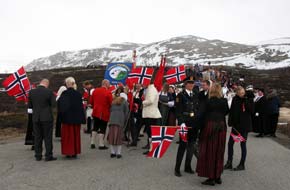 welcome by the
owner Anne-Ma Hoelsbrekken and her husband Terje (Photo
32 - Bjørkhol Camping), who gave us all the details
and timing of local arrangements for tomorrow's 17 May National Day celebrations
when the 3 communes of Oppdal, Dombås and Dovre would combine their processions
at Hjerkinn high on Dovrefjell. National Day this year would be extra-special
being the 200th anniversary of Norway gaining its semi-autonomous constitution
under the 1814 union with Sweden; it took another 100 years for Good King Oscar
II to grant Norway full independent statehood in 1905. It all sounded so
jolly with everyone in their national costumes that we decided to attend. Bjørkhol
Camping was beautifully laid out in an idyllic setting, its flat grassy camping
area backed by a birch and pine wooded hill and the far side of the valley welcome by the
owner Anne-Ma Hoelsbrekken and her husband Terje (Photo
32 - Bjørkhol Camping), who gave us all the details
and timing of local arrangements for tomorrow's 17 May National Day celebrations
when the 3 communes of Oppdal, Dombås and Dovre would combine their processions
at Hjerkinn high on Dovrefjell. National Day this year would be extra-special
being the 200th anniversary of Norway gaining its semi-autonomous constitution
under the 1814 union with Sweden; it took another 100 years for Good King Oscar
II to grant Norway full independent statehood in 1905. It all sounded so
jolly with everyone in their national costumes that we decided to attend. Bjørkhol
Camping was beautifully laid out in an idyllic setting, its flat grassy camping
area backed by a birch and pine wooded hill and the far side of the valley
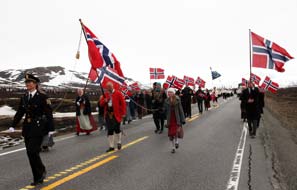 enclosed by snow-covered fells. We happily settled into this wonderfully
peaceful and hospitable campsite after our long day. enclosed by snow-covered fells. We happily settled into this wonderfully
peaceful and hospitable campsite after our long day.
Sharing Norway's National Day celebrations
with the communities of Oppdal, Dombås and Dovre at Hjerkinn on Dovrefjell:
we were up early to be away at 9-00 am to drive back up through Dombås and join
all the local cars heading to Hjerkinn; the weather was far from festive on this
special day, gloomily overcast with a bitingly cold northerly wind blowing
across the bleak Dovre fells. Reaching Hjerkinn, marshals directed the 100s of
cars and buses bringing participants from all the 3 distant communes into
parking areas on the fellside dirt road which led up to the Snøhetta viewpoint.
Everyone was wearing their Norwegian national costumes and waving their flags,
and we in all our layers of arctic gear against the bitterly cold wind joined
the gathering crowds of celebrants from Oppdal. With their local bands,
drum-majorettes and school groups led by their banners, they formed up into
their parade that would process down E6 to link up with similar
processions from the other 2 communes (see above right) (Photo
33 - Forming up for 2014 National Day procession). The main E6 road would be closed between
10-00 and 11-00am to allow the parades to pass; only in tolerant Norway would
drivers sit patiently in a traffic queue for an hour on the country's major
highway. Participants were dressed in a variety of national costumes; some
looked shiveringly cold, others at least had capes or anoraks against the biting
northerly wind blowing across the bleak Dovre fells. We positioned ourselves to
the head of the procession forming where the fell-road joined E6, eventually
leading off with a sea of waving flags along the main road led by a police-lady
march-stepping to the rhythm of the bands (see above left) (Photo
34 - 2014 National Day procession at Dovrefjell). The long parade was a mixture of
school and kindergarten groups with their banners (see right), family groups all in national
dress pushing buggies decorated with flags and sprigs of birch, and individuals
such as the granny proudly hand-in-hand with her little grandson. to link up with similar
processions from the other 2 communes (see above right) (Photo
33 - Forming up for 2014 National Day procession). The main E6 road would be closed between
10-00 and 11-00am to allow the parades to pass; only in tolerant Norway would
drivers sit patiently in a traffic queue for an hour on the country's major
highway. Participants were dressed in a variety of national costumes; some
looked shiveringly cold, others at least had capes or anoraks against the biting
northerly wind blowing across the bleak Dovre fells. We positioned ourselves to
the head of the procession forming where the fell-road joined E6, eventually
leading off with a sea of waving flags along the main road led by a police-lady
march-stepping to the rhythm of the bands (see above left) (Photo
34 - 2014 National Day procession at Dovrefjell). The long parade was a mixture of
school and kindergarten groups with their banners (see right), family groups all in national
dress pushing buggies decorated with flags and sprigs of birch, and individuals
such as the granny proudly hand-in-hand with her little grandson.
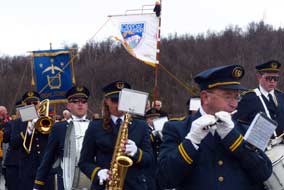 In the dull light and misty rain, we followed the
procession along E6 taking photos as best we could trying to keep lens free of
rain spots, and joining in the shouts of 'hoorah' as groups passed us. In
today's hurried and over-sophisticated world, the celebrations were all delightfully straightforward
with bands playing (see left) and participants proudly waving their flags and banners oblivious to the
drizzle and bitingly cold wind. As we approached Hjerkinn, the Oppdal procession
joined up with those from the other 2 communes who had paraded along E6 to the
south and from Hjerkinn to meet up at the junction, a sea of national costumes
and waving flags against the proud backdrop of the snow-covered Dovre mountains
in the gloomy fell-land light. The merged crowds drifted up towards Hjerkinn
station where a stage was set up for the continued celebrations. In the dull light and misty rain, we followed the
procession along E6 taking photos as best we could trying to keep lens free of
rain spots, and joining in the shouts of 'hoorah' as groups passed us. In
today's hurried and over-sophisticated world, the celebrations were all delightfully straightforward
with bands playing (see left) and participants proudly waving their flags and banners oblivious to the
drizzle and bitingly cold wind. As we approached Hjerkinn, the Oppdal procession
joined up with those from the other 2 communes who had paraded along E6 to the
south and from Hjerkinn to meet up at the junction, a sea of national costumes
and waving flags against the proud backdrop of the snow-covered Dovre mountains
in the gloomy fell-land light. The merged crowds drifted up towards Hjerkinn
station where a stage was set up for the continued celebrations.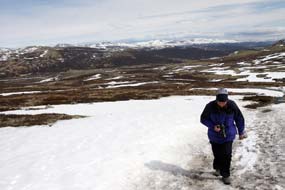 Family groups
and individuals all waving their flags greeted one another, and we met up with
Anne-Ma from the campsite. A well-known Norwegian actor recited a dramatic piece
about King Harald and 'Gamle Dovre', and the official events concluded with the
singing of the national anthem which we hummed along to. Family groups
and individuals all waving their flags greeted one another, and we met up with
Anne-Ma from the campsite. A well-known Norwegian actor recited a dramatic piece
about King Harald and 'Gamle Dovre', and the official events concluded with the
singing of the national anthem which we hummed along to.
An afternoon on Dovrefjell at the Snøhetta
look-out and first encounter with wild musk oxen: after the gloomy
conditions for this morning's National Day celebrations, as we walked back along
the fell-road to where George was parked the sky was beginning to brighten; it
looked likely to be a sunny afternoon for a walk up to the Tverrfjell look-out
point for the views across to the Dovre mountain heartland
of Snøhetta. We kitted up and began the long uphill walk on a good footpath up the bare
fell-side. As the gradient steepened, the path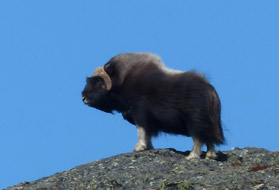 crossed increasing amounts of
residual snow and running melt-water (see right) (Photo
35 - Snowy walk up Tverrfjell). Almost at the look-out, a group of
Norwegians alerted our attention to a small group of Dovrefjell's wild musk oxen
population grazing on the distant fell-side. We pressed on hoping they would not
be disturbed before we drew closer. The path flattened onto a high plateau as we
reached the look-out point; and there the musk oxen stood still quietly grazing,
silhouetted against the skyline some 300m away (see left). So astonished were we at this
unexpected encounter with Dovrefjell's legendary beasts that initially we
totally ignored the spectacular mountainous panorama of the entire snow-covered Snøhetta
range with its magnificent corrie and sky-line of serrated peaks, all against a
blue sky and lit by bright sunshine (see below left) (Photo
36 - Snøhetta range). Perched on a high-point crest of Tverrfjell
overlooking a broad sweeping depression, the Snøhetta look-out was tastefully
set up, its curved wooden interior warmed by a log fire and its glazed wall
looking out towards the Snøhetta panorama. Outside, although the sun was bright,
the arctic wind was cuttingly chill. The National Park warden gave us background
information on musk oxen and their re-introduction to Dovrefjell after WW2. Our
attention was torn between photographing the musk oxen and the other remarkable
natural feast, that of the Snøhetta's mountainous panorama lit by wonderfully
bright sunshine. It scarcely seemed the same day as the gloomy, dismal weather
of this morning. But what a day of experiences today had been. We had been
triply blessed on Norway's National Day: this morning's parades, and this
afternoon Dovrefjell's musk oxen and the Snøhetta panorama in bright sunshine.
Contentedly we descended the fell-path, passing the snow melts which glistened
in the sunshine (Photo
37 - Sun-lit snow-melts) and crossing the desolate Dovrefjell railway line over which the
giant Dovre Gubben steam locomotives hauled Trondheim expresses in the 1950s (Photo
38 - Dovrefjell railway). crossed increasing amounts of
residual snow and running melt-water (see right) (Photo
35 - Snowy walk up Tverrfjell). Almost at the look-out, a group of
Norwegians alerted our attention to a small group of Dovrefjell's wild musk oxen
population grazing on the distant fell-side. We pressed on hoping they would not
be disturbed before we drew closer. The path flattened onto a high plateau as we
reached the look-out point; and there the musk oxen stood still quietly grazing,
silhouetted against the skyline some 300m away (see left). So astonished were we at this
unexpected encounter with Dovrefjell's legendary beasts that initially we
totally ignored the spectacular mountainous panorama of the entire snow-covered Snøhetta
range with its magnificent corrie and sky-line of serrated peaks, all against a
blue sky and lit by bright sunshine (see below left) (Photo
36 - Snøhetta range). Perched on a high-point crest of Tverrfjell
overlooking a broad sweeping depression, the Snøhetta look-out was tastefully
set up, its curved wooden interior warmed by a log fire and its glazed wall
looking out towards the Snøhetta panorama. Outside, although the sun was bright,
the arctic wind was cuttingly chill. The National Park warden gave us background
information on musk oxen and their re-introduction to Dovrefjell after WW2. Our
attention was torn between photographing the musk oxen and the other remarkable
natural feast, that of the Snøhetta's mountainous panorama lit by wonderfully
bright sunshine. It scarcely seemed the same day as the gloomy, dismal weather
of this morning. But what a day of experiences today had been. We had been
triply blessed on Norway's National Day: this morning's parades, and this
afternoon Dovrefjell's musk oxen and the Snøhetta panorama in bright sunshine.
Contentedly we descended the fell-path, passing the snow melts which glistened
in the sunshine (Photo
37 - Sun-lit snow-melts) and crossing the desolate Dovrefjell railway line over which the
giant Dovre Gubben steam locomotives hauled Trondheim expresses in the 1950s (Photo
38 - Dovrefjell railway).
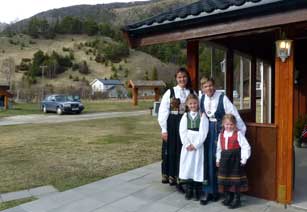 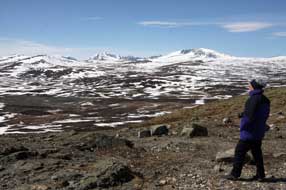 The E6 was deserted now after this morning's festivities, as we returned to Dombås and down to the lower valley to Bjørkhol Camping to settle in again. Anne-Ma's 2 little grandchildren still dressed in their national costume were
playing on their granny's trampoline. The younger 5 year old whose name we
managed to establish was Inge came over and could not understand why these
curious adults failed to respond to her chattering. Anne-Ma introduced us to her
daughter and granddaughters (see right) who were around 1 year younger than our own
granddaughters, and in the bright afternoon sunshine they pointed out a golden
eagle soaring over the high fells enclosing the valley. Our stay at Bjørkhol
Camping had indeed been a memorably happy one, and long should we recall this
lovely campsite and its owners' unassuming hospitality. The E6 was deserted now after this morning's festivities, as we returned to Dombås and down to the lower valley to Bjørkhol Camping to settle in again. Anne-Ma's 2 little grandchildren still dressed in their national costume were
playing on their granny's trampoline. The younger 5 year old whose name we
managed to establish was Inge came over and could not understand why these
curious adults failed to respond to her chattering. Anne-Ma introduced us to her
daughter and granddaughters (see right) who were around 1 year younger than our own
granddaughters, and in the bright afternoon sunshine they pointed out a golden
eagle soaring over the high fells enclosing the valley. Our stay at Bjørkhol
Camping had indeed been a memorably happy one, and long should we recall this
lovely campsite and its owners' unassuming hospitality.
Fokstumyra Marshes nature reserve:
on a gloriously warm, sunny morning, at least here
down in the lower valley, there was for the first time this trip a real feeling
of Spring in the air, with the birches now coming into full leaf. Waving 'Ha det
bra' to Anne-Ma, we finally left Bjørkhol to drive back up to Dombås, turning up
the E6 long hill beyond the town. Our first stop today was the nature reserve of
the Fokstumyra Marshes, and on a quiet Sunday morning we turned off E6 to the
parking area by the little Fokstuga station-halt on the Dovrefjell railway. The
weather was perfect with blue sky, little wind and warm, bright sunshine. We
kitted up with boots and gaiters given the
 unexpected amounts of residual snow
and set off with cameras and binoculars (see left). A 7 kms board-walk pathway circles the
marshes with a bird observation-tower part-way round. The approach path crossed
under the railway line by a low tunnel almost blocked by snow and ice, and the
sun glistening on snow and lighting the stunted birches provided rich
photographic opportunity (Photo
39 - Sun-lit snow at Fokstumyra Marshes nature reserve). The marshland was covered with low willow scrub and
backed by the distant panorama of the Dovrefjell mountainous skyline; other than
the song of unseen marshland birds it was gloriously peaceful, and we saw not
another soul all afternoon (Photo
40 - Fokstumyra Marshes). unexpected amounts of residual snow
and set off with cameras and binoculars (see left). A 7 kms board-walk pathway circles the
marshes with a bird observation-tower part-way round. The approach path crossed
under the railway line by a low tunnel almost blocked by snow and ice, and the
sun glistening on snow and lighting the stunted birches provided rich
photographic opportunity (Photo
39 - Sun-lit snow at Fokstumyra Marshes nature reserve). The marshland was covered with low willow scrub and
backed by the distant panorama of the Dovrefjell mountainous skyline; other than
the song of unseen marshland birds it was gloriously peaceful, and we saw not
another soul all afternoon (Photo
40 - Fokstumyra Marshes).
The board-walk built 2 feet above the marshes was
generally well-maintained, and we made good progress around the first section,
turning westwards to reach the bird observation-tower. Clambering up into this,
we took up position with binoculars for the open views across the marshland
towards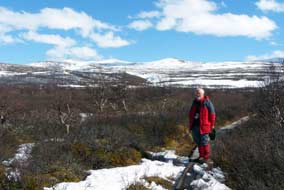 partially frozen lakes against the back-drop of the Dovre mountains to
the west. Over the next couple of hours, we saw a crane stalking among the
marshes with its long curving neck and bulky tail-bustle, a male hen-harrier
with its black-tipped long pointed wings patrolling the skies and occasionally
swooping into the marshes for prey, gulls and a kestrel soaring over the lake,
and a black-throated diver with its distinctive silhouette sitting on the lake
edge. We also heard the distinctive crescendo-call of curlews across the lake. partially frozen lakes against the back-drop of the Dovre mountains to
the west. Over the next couple of hours, we saw a crane stalking among the
marshes with its long curving neck and bulky tail-bustle, a male hen-harrier
with its black-tipped long pointed wings patrolling the skies and occasionally
swooping into the marshes for prey, gulls and a kestrel soaring over the lake,
and a black-throated diver with its distinctive silhouette sitting on the lake
edge. We also heard the distinctive crescendo-call of curlews across the lake.
We continued further around the marshland circuit,
but here greater areas of soft, residual snow totally obscured the line of the
board-walk; even following the boot-prints of earlier walkers, it took little to
falter from the narrow boards and sink deep into the snow-covered marsh. There
was no way we were going to complete the circuit with dry feet, and we returned to
the railway line and the car park. In such perfect conditions, this had been
a superb afternoon enjoying of the bird-life and the peaceful snowy conditions of the little-known Fokstumyra
Marshes (see right) (Photo
41 - Peaceful snowy conditions at Fokstumyra Marshes).
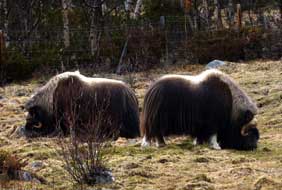 A close encounter with Dovrefjell's wild musk
oxen: the following
morning, with the weather now disappointingly overcast, we headed NW on E6
across Dovrefjell past the still partially frozen lakes to follow the
fast-flowing river down towards Kongsvoll. As we approached the mountain-inn, we
pulled into a lay-by, scouring the fells for possible sign of the musk oxen. We
had been told of a point on the far side of the river, where it was possible in
safety to stand quite close to the grazing beast. Following a track under the
railway, there ahead on the fell-side were some 6 musk-oxen, and protected
by a fence, we moved to within 100m of the beast which continued grazing totally
oblivious to our presence (Photo
42 - Dovrefjell Musk Oxen). We had a truly unbelievable viewpoint for close
observation of these remarkable primeval survivors (Photo
43 - Dovrefjell Musk Ox). A close encounter with Dovrefjell's wild musk
oxen: the following
morning, with the weather now disappointingly overcast, we headed NW on E6
across Dovrefjell past the still partially frozen lakes to follow the
fast-flowing river down towards Kongsvoll. As we approached the mountain-inn, we
pulled into a lay-by, scouring the fells for possible sign of the musk oxen. We
had been told of a point on the far side of the river, where it was possible in
safety to stand quite close to the grazing beast. Following a track under the
railway, there ahead on the fell-side were some 6 musk-oxen, and protected
by a fence, we moved to within 100m of the beast which continued grazing totally
oblivious to our presence (Photo
42 - Dovrefjell Musk Oxen). We had a truly unbelievable viewpoint for close
observation of these remarkable primeval survivors (Photo
43 - Dovrefjell Musk Ox).
 The musk ox (Ovibus muschatus), a truly prehistoric beast which has
changed little in 2 million years, is a bovine ruminant herbivore which bears
little resemblance to any other animal; its only known relative is the Takin of
northern Tibet. They weigh up to 450 kgms (almost half a ton) with high
shoulders giving the impression of a humped back, and enormous low-slung head
with broad, flat horns curving outwards. The body is covered with a thick coat
of shaggy hair over a matted fleece of soft fur as protection against arctic
winter temperatures. Only the bottom of its legs and enormous hooves protrude,
giving it a tank-like appearance. The females have calved in springtime, and the
herd grazes the arctic high fells and tundra eating continuously during the
summer to build up a protective layer of fat for the coming winter, when they
stand for hours perfectly still to conserve energy, almost like standing
hibernation. They are not inherently aggressive animals unless disturbed, when
their defence against threat is to attack. Despite their weight and bulk, they
can charge at speeds of up to 60kph. As an illustration of their speed
potential, the human world record for 100m stands at 9.5 seconds; a charging
musk ox can cover this distance in 6 seconds, and you are advised not to
approach on the open fell-side closer than 200m! They inhabited Norway from the
last Ice Age, but became extinct around 2,000 years ago, surviving
naturally only in Greenland and Arctic Northern Canada. A few musk oxen were
re-introduced to the high fells of Dovrefjell National Park after WW2 and since
then the wild herd has grown to around 100 beast. The musk ox (Ovibus muschatus), a truly prehistoric beast which has
changed little in 2 million years, is a bovine ruminant herbivore which bears
little resemblance to any other animal; its only known relative is the Takin of
northern Tibet. They weigh up to 450 kgms (almost half a ton) with high
shoulders giving the impression of a humped back, and enormous low-slung head
with broad, flat horns curving outwards. The body is covered with a thick coat
of shaggy hair over a matted fleece of soft fur as protection against arctic
winter temperatures. Only the bottom of its legs and enormous hooves protrude,
giving it a tank-like appearance. The females have calved in springtime, and the
herd grazes the arctic high fells and tundra eating continuously during the
summer to build up a protective layer of fat for the coming winter, when they
stand for hours perfectly still to conserve energy, almost like standing
hibernation. They are not inherently aggressive animals unless disturbed, when
their defence against threat is to attack. Despite their weight and bulk, they
can charge at speeds of up to 60kph. As an illustration of their speed
potential, the human world record for 100m stands at 9.5 seconds; a charging
musk ox can cover this distance in 6 seconds, and you are advised not to
approach on the open fell-side closer than 200m! They inhabited Norway from the
last Ice Age, but became extinct around 2,000 years ago, surviving
naturally only in Greenland and Arctic Northern Canada. A few musk oxen were
re-introduced to the high fells of Dovrefjell National Park after WW2 and since
then the wild herd has grown to around 100 beast.
You can pay over £30 to be taken on a commercial musk oxen safari, and here we
were stood peering through our binoculars and photographing 6 of the hefty wild
creatures as they grazed the fell-side. A selection of our musk oxen photographs
is given on our
Flora and Fauna of SE Norway
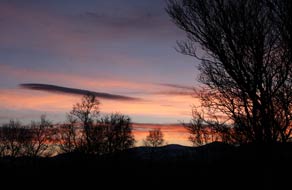 We had identified a campsite for tonight a short
distance along E6, and tuned up a fell-land dirt-road leading up to Furulaugli Camping where the owner treated us
to an un-smiling, ill-gracious non-welcome; what a contrast with the welcome we
had received at Bjørkhol. Anne-Ma could make a fortune teaching other campsite
owners and their staff the elementary commercial common sense of basic courtesy
and a smile! It was another of those campsites where all the basic facilities
cost extra, but we settled in for a night's stay. The camping area set high on
the fell-side was still bare after the recently melted snow, but on a sunny,
windless late afternoon, the westward view faced Dovrefjell's skyline and we heard the first cuckoo of this Spring. The sun settled late below
the glorious mountainous horizon, and although it stayed light that evening, we
were treated to the trip's first crimson sunset with silhouetted birches (Photo
44 - Dovrefjell Sunset). We had identified a campsite for tonight a short
distance along E6, and tuned up a fell-land dirt-road leading up to Furulaugli Camping where the owner treated us
to an un-smiling, ill-gracious non-welcome; what a contrast with the welcome we
had received at Bjørkhol. Anne-Ma could make a fortune teaching other campsite
owners and their staff the elementary commercial common sense of basic courtesy
and a smile! It was another of those campsites where all the basic facilities
cost extra, but we settled in for a night's stay. The camping area set high on
the fell-side was still bare after the recently melted snow, but on a sunny,
windless late afternoon, the westward view faced Dovrefjell's skyline and we heard the first cuckoo of this Spring. The sun settled late below
the glorious mountainous horizon, and although it stayed light that evening, we
were treated to the trip's first crimson sunset with silhouetted birches (Photo
44 - Dovrefjell Sunset).
Next week, we move north to visit the historical city
of Trondheim with its Gothic medieval Nidaros Cathedral associated with the cult
of St Olaf Norway's patron
saint, see Tirpitz's anchorage and memorial to RAF crews at Fjættenfjord in the inner
recesses of Trondheimsfjord, visit the site of St Olaf's death on the
Battlefield of Stiklestad, drive the long E6 road north to Mosjøen and Mo i Rana,
cross the Arctic Circle on the snow-bound barren wastes of Saltfjell, descend to
the fertile green valley at Rognan and the site of yet more WW2 German barbarism, visit the collection of historic aircraft at Bodø's Aviation Museum,
and continue ever northwards to Skutvik ready for the ferry-crossing to the Lofoten
Islands. Join us again shortly for the next edition and add the site to your
Favourites.
Next edition
to be published quite soon
|
Sheila and Paul |
Published: 6 July 2014 at
Nordkapp |
|

 CAMPING
IN NORWAY 2014 - SE Norway and Lillehammer, Eastern Jotunheimen Mountains,
Gudbrandsdalen, Norway's National Day (17 May), Rondane and Dovrefjell National Parks:
CAMPING
IN NORWAY 2014 - SE Norway and Lillehammer, Eastern Jotunheimen Mountains,
Gudbrandsdalen, Norway's National Day (17 May), Rondane and Dovrefjell National Parks: spend its public funding to better effect, and we told them so.
spend its public funding to better effect, and we told them so.  mountains not
completed until 1921. The south coast line to Kristiansand was not completed
until 1938 and the continuation to Stavanger only in 1944.The northern main
line was the last to open with the final stretch from Fauske to Bodø not opening
until 1962; parts of the line's civil engineering construction was by Russian
and Slavic slave labour under German WW2 occupation. The rail route to Bergen
over the central mountains was completed in 1909 with the highest point of the
line at 1,222m, and the extension from Myrdal at 866m down to sea level at Flåm
on the Sognfjord was opened in 1941. These lines served to develope the
burgeoning ski trade and tourist industry.
mountains not
completed until 1921. The south coast line to Kristiansand was not completed
until 1938 and the continuation to Stavanger only in 1944.The northern main
line was the last to open with the final stretch from Fauske to Bodø not opening
until 1962; parts of the line's civil engineering construction was by Russian
and Slavic slave labour under German WW2 occupation. The rail route to Bergen
over the central mountains was completed in 1909 with the highest point of the
line at 1,222m, and the extension from Myrdal at 866m down to sea level at Flåm
on the Sognfjord was opened in 1941. These lines served to develope the
burgeoning ski trade and tourist industry. The
sadly inadequate display took all of 10 minutes, and the reception lady, clearly
sensing our frustration, offered to arrange for Svein Krogrud, one of the
museum's project advisers and himself a retired railway man, to show us the
modest collection of steam locomotives. The first of the engine sheds contained
an early electric loco used in the 1930s on the Oslo~Drammen line, and 2
mid-20th century express passenger steam locomotives (see left). The next shed
housed the pride of the small collection, one of five massive 2-8-4 4-cylinder
engines weighing 153 tons and built between 1935~41 by Krupps of Essen for
hauling passenger trains on the Trondheim line over the treacherous Dovre
Mountains, hence they were called the Dovre Gubben (Dovre Giants) (
The
sadly inadequate display took all of 10 minutes, and the reception lady, clearly
sensing our frustration, offered to arrange for Svein Krogrud, one of the
museum's project advisers and himself a retired railway man, to show us the
modest collection of steam locomotives. The first of the engine sheds contained
an early electric loco used in the 1930s on the Oslo~Drammen line, and 2
mid-20th century express passenger steam locomotives (see left). The next shed
housed the pride of the small collection, one of five massive 2-8-4 4-cylinder
engines weighing 153 tons and built between 1935~41 by Krupps of Essen for
hauling passenger trains on the Trondheim line over the treacherous Dovre
Mountains, hence they were called the Dovre Gubben (Dovre Giants) ( evident on the slopes; but at least the forecast showed improving weather over the coming days. Our
first stop this morning was the Norsk Vegmuseum (Museum of Road Construction) just along the lane, run by the Statens Vegvesen (State Road Authority). This
tells the story of both constructing the road network in Norway's challenging
terrain and maintaining it over winter. Uphill on the craggy fellside, the
Fjellsprengnings-museum (Rock-blasting Museum) is a 240m section of road tunnel
giving insight into the construction of road tunnels through Norwegian
mountains. And more to the point, the museum was free-entry. But disappointment
again: the museums were only open at weekends in May. We could walk around the
outdoor displays on a trail through the pine woods under the towering cliffs of
the craggy fellside, but there was little to see other than a few pieces of road
building or maintenance machinery and mini-skansen of road-associated buildings.
We walked the circuit anyway since the natural forest floor was just beginning
to come alive again after the winter snows with a covering of lingonberries in
tiny bud and bilberries with fresh green new leaf and globular pink early flowers. The
track-way circled back higher up the fellside with displays of modern
snow-clearing equipment, monster dumper-trucks (see left) and the portal of the
tunnel-building simulation of the Rock-blasting Museum (
evident on the slopes; but at least the forecast showed improving weather over the coming days. Our
first stop this morning was the Norsk Vegmuseum (Museum of Road Construction) just along the lane, run by the Statens Vegvesen (State Road Authority). This
tells the story of both constructing the road network in Norway's challenging
terrain and maintaining it over winter. Uphill on the craggy fellside, the
Fjellsprengnings-museum (Rock-blasting Museum) is a 240m section of road tunnel
giving insight into the construction of road tunnels through Norwegian
mountains. And more to the point, the museum was free-entry. But disappointment
again: the museums were only open at weekends in May. We could walk around the
outdoor displays on a trail through the pine woods under the towering cliffs of
the craggy fellside, but there was little to see other than a few pieces of road
building or maintenance machinery and mini-skansen of road-associated buildings.
We walked the circuit anyway since the natural forest floor was just beginning
to come alive again after the winter snows with a covering of lingonberries in
tiny bud and bilberries with fresh green new leaf and globular pink early flowers. The
track-way circled back higher up the fellside with displays of modern
snow-clearing equipment, monster dumper-trucks (see left) and the portal of the
tunnel-building simulation of the Rock-blasting Museum ( Lillehammer's 1994 Winter Olympics Ski-Jump: rejoining E6 back to Lillehammer, there was little reason for turning off into the town
other than to investigate the giant ski-jump which was visible above the town
for miles around. Lillehammer is one of Norway's foremost ski-resorts, and won
its bid to host the 1994 Winter Olympics. The Norwegian government invested a
massive 2 billion kroner in sporting facilities and infrastructure: ski-jumps,
ski- and bob-sleigh runs on the hill slopes above the town, with stadium and
chair-lifts, all of which remain in use today. From the TIC by the railway
station, we established the best route to approach the ski-jump and wound our way
uncertainly up the steep hillside to the foot of the enormous jump which
Lillehammer's 1994 Winter Olympics Ski-Jump: rejoining E6 back to Lillehammer, there was little reason for turning off into the town
other than to investigate the giant ski-jump which was visible above the town
for miles around. Lillehammer is one of Norway's foremost ski-resorts, and won
its bid to host the 1994 Winter Olympics. The Norwegian government invested a
massive 2 billion kroner in sporting facilities and infrastructure: ski-jumps,
ski- and bob-sleigh runs on the hill slopes above the town, with stadium and
chair-lifts, all of which remain in use today. From the TIC by the railway
station, we established the best route to approach the ski-jump and wound our way
uncertainly up the steep hillside to the foot of the enormous jump which
 careered down the slopes above. The lane continued uphill to the huge
landing area at the foot of the ski-jump. The main ski-jump drops 136m with a landing-slope angle of 37.5°; the speed on take-off is a terrifying 86 mph, and
the 1994 gold medallist's longest leap was an astonishing 104m. We walked up to
the perimeter overlooking the landing area, giving us a clear view looking
straight up the entire length of the jump (see right) (
careered down the slopes above. The lane continued uphill to the huge
landing area at the foot of the ski-jump. The main ski-jump drops 136m with a landing-slope angle of 37.5°; the speed on take-off is a terrifying 86 mph, and
the 1994 gold medallist's longest leap was an astonishing 104m. We walked up to
the perimeter overlooking the landing area, giving us a clear view looking
straight up the entire length of the jump (see right) ( the
air warmer and not a breath of wind, a hazy sun lit the hills on the far side of
the lake with a small church reflected in the still water. Through
the small industrial town of Gjøvik, we turned westwards onto the quiet Route
33, gaining height gradually into forested rolling hill-farming countryside.
Snow still lined the north-facing shaded side of the road under pines, while
wood anemones covered the verges on the sunlit side.
the
air warmer and not a breath of wind, a hazy sun lit the hills on the far side of
the lake with a small church reflected in the still water. Through
the small industrial town of Gjøvik, we turned westwards onto the quiet Route
33, gaining height gradually into forested rolling hill-farming countryside.
Snow still lined the north-facing shaded side of the road under pines, while
wood anemones covered the verges on the sunlit side.
 The road descended into a
broad lake-filled valley just beyond the small settlement of Dokka, and hazy
sunshine heightened the contrasting greens of the mixed pine and birch woods
covering the side hills: the glum, dark of the pines and the fresh pale green of
the birches' new leaf. Beyond Etnadalen with its fast-flowing white-water river,
the road climbed more steeply on sweeping narrow bends with increasing amounts
of snow and frozen, snow-bound lakes. Over the watershed of this shoulder of
hills, we began the long descent into the lovely valley of Aurdalen and the
junction with Route 16, the main Oslo~Bergen road, which continued high along
the valley side. Rounding the end of Strondafjorden, we reached Fagernes and
pulled into the lakeside campsite. Their website claimed that 'the most idyllic
spots were reserved for visitors', and it was true: at the far end we found a
peaceful, secluded corner terraced into the wooded hillside and overlooking the
lake (see left). The girl on reception was insistently helpful sorting out password for the
site-wide wi-fi, the setting was indeed idyllic, and facilities first class with
well-equipped kitchen and beautifully furnished common room; the only down-side
was cost at 250 NOK but we negotiated an inclusive price for the luxurious showers
(usually extra), and enjoyed a productive day in camp at this worthy site.
The road descended into a
broad lake-filled valley just beyond the small settlement of Dokka, and hazy
sunshine heightened the contrasting greens of the mixed pine and birch woods
covering the side hills: the glum, dark of the pines and the fresh pale green of
the birches' new leaf. Beyond Etnadalen with its fast-flowing white-water river,
the road climbed more steeply on sweeping narrow bends with increasing amounts
of snow and frozen, snow-bound lakes. Over the watershed of this shoulder of
hills, we began the long descent into the lovely valley of Aurdalen and the
junction with Route 16, the main Oslo~Bergen road, which continued high along
the valley side. Rounding the end of Strondafjorden, we reached Fagernes and
pulled into the lakeside campsite. Their website claimed that 'the most idyllic
spots were reserved for visitors', and it was true: at the far end we found a
peaceful, secluded corner terraced into the wooded hillside and overlooking the
lake (see left). The girl on reception was insistently helpful sorting out password for the
site-wide wi-fi, the setting was indeed idyllic, and facilities first class with
well-equipped kitchen and beautifully furnished common room; the only down-side
was cost at 250 NOK but we negotiated an inclusive price for the luxurious showers
(usually extra), and enjoyed a productive day in camp at this worthy site. The Valdresflye pass (Route 51) over the
eastern shoulder of the Jotunheimen Mountains: our onward route from Fagernes would take us over the 4,500 feet high Valdresflye pass (Route 51) which
crosses the eastern shoulder of the Jotunheimen Mountains. See the
The Valdresflye pass (Route 51) over the
eastern shoulder of the Jotunheimen Mountains: our onward route from Fagernes would take us over the 4,500 feet high Valdresflye pass (Route 51) which
crosses the eastern shoulder of the Jotunheimen Mountains. See the  Hegge Stave Church: scattered
hill-farms dotted the hillsides lining the lower valley where the surface of
lakes, even at this low altitude, were still partly frozen. At the northern end
of the farming settlement of Heggenes, we paused to walk up to Hegge Stavkirke
(see right). Hegge stave church was built around 1281, the
capitals of its 8 columns were carved with faces, one having just one eye
resembling Odin as if the pagan gods were condemned to the demeaning role of
supporting the new Christian church's roof. The carved altarpiece dates from
1782, and the story goes that 4 farmers from Hegge, after trading cattle in
Gudbrandsdalen, were lost in a storm on their return through the mountains. They
swore that if they returned home safely, each would donate the value of a cow
for a new altarpiece. They kept their promise and a new altarpiece was ordered;
bringing it home however on a sledge in the winter snow, they lost the figure of
Judas which was found the following summer its paintwork faded (
Hegge Stave Church: scattered
hill-farms dotted the hillsides lining the lower valley where the surface of
lakes, even at this low altitude, were still partly frozen. At the northern end
of the farming settlement of Heggenes, we paused to walk up to Hegge Stavkirke
(see right). Hegge stave church was built around 1281, the
capitals of its 8 columns were carved with faces, one having just one eye
resembling Odin as if the pagan gods were condemned to the demeaning role of
supporting the new Christian church's roof. The carved altarpiece dates from
1782, and the story goes that 4 farmers from Hegge, after trading cattle in
Gudbrandsdalen, were lost in a storm on their return through the mountains. They
swore that if they returned home safely, each would donate the value of a cow
for a new altarpiece. They kept their promise and a new altarpiece was ordered;
bringing it home however on a sledge in the winter snow, they lost the figure of
Judas which was found the following summer its paintwork faded ( Crossing the snow-bound
Valdresflye:
reaching the ski resort of Beitostølen the sky cleared to give bright warming
sunshine, and with the weather now looking good these were ideal conditions to
continue over the highest part of the Valdresflye plateau. The road now gained
height becoming a tarmac mini-canyon enclosed within snow-banks 2~3m high on
both sides, with snow-poles poking out above the snow-banks (see above left), pines and birches
on the hills standing out among surrounding snow fields, and ahead the 1608m
peak of Bitihorn towering over the road (
Crossing the snow-bound
Valdresflye:
reaching the ski resort of Beitostølen the sky cleared to give bright warming
sunshine, and with the weather now looking good these were ideal conditions to
continue over the highest part of the Valdresflye plateau. The road now gained
height becoming a tarmac mini-canyon enclosed within snow-banks 2~3m high on
both sides, with snow-poles poking out above the snow-banks (see above left), pines and birches
on the hills standing out among surrounding snow fields, and ahead the 1608m
peak of Bitihorn towering over the road ( open to traffic from April~October must be a nightmare, with constantly changing weather conditions and still so much
residual snow. The tarmac ribbon of road carved through
snow-banks wound around sweeping curves to a high point and began the descent to
the inn at the eastern end of Lake Bygdin; but despite the lake's huge length,
today it was totally frozen and indistinguishable amid the covering of snow
fields (
open to traffic from April~October must be a nightmare, with constantly changing weather conditions and still so much
residual snow. The tarmac ribbon of road carved through
snow-banks wound around sweeping curves to a high point and began the descent to
the inn at the eastern end of Lake Bygdin; but despite the lake's huge length,
today it was totally frozen and indistinguishable amid the covering of snow
fields ( the narrow
ribbon of road levelled onto the plateau top to approach the highest point at
1,389m (4,555 feet), where the sign marking the pass' high point was half buried
in a snow bank (see above right) (
the narrow
ribbon of road levelled onto the plateau top to approach the highest point at
1,389m (4,555 feet), where the sign marking the pass' high point was half buried
in a snow bank (see above right) ( which stretched away into the distance marked with ski trails
with the afternoon sun glistening on the shiny crust of the snow (see right) (
which stretched away into the distance marked with ski trails
with the afternoon sun glistening on the shiny crust of the snow (see right) ( A
hospitable campsite, the
Jotunheimen Feriesenter:
starting down the descent from the plateau in long sweeping curves,
we reached a
view point looking along the shapely length of the Knutshö crested ridge-line
(
A
hospitable campsite, the
Jotunheimen Feriesenter:
starting down the descent from the plateau in long sweeping curves,
we reached a
view point looking along the shapely length of the Knutshö crested ridge-line
( river. Below the tree where
pines covered the lower slopes, we turned onto Route 257 at the road junction of
Randsverk and 2kms further reached tonight's campsite Jotunheimen Feriesenter.
Here we were welcomed by the delightfully hospitable Petrita
who has kept the campsite single-handedly for 27 years, and who insisted on
helping us find solid ground where the snow had recently melted (
river. Below the tree where
pines covered the lower slopes, we turned onto Route 257 at the road junction of
Randsverk and 2kms further reached tonight's campsite Jotunheimen Feriesenter.
Here we were welcomed by the delightfully hospitable Petrita
who has kept the campsite single-handedly for 27 years, and who insisted on
helping us find solid ground where the snow had recently melted (
 Gjendesheim, closed at this time of year, at the eastern end of Gjende set high
above the frozen, snow-covered outflow of the lake, and rounding a shoulder of
the hillside, spread out ahead was the glorious spectacle of Gjende's full
panorama (see right): the length of the lake was totally frozen and snow-covered, and
surrounded by magnificent mountains enclosed on the northern side by the
bulky massif of Veslfjell and the crest of Besseggen just visible at the far end.
The southern side of the lake was enclosed by the low summit of Gjendeshö and
peeping out above this the higher peaks of the
Knutshö crested ridge. In the distance at the far
end of Lake Gjende, a spectacular array of the central Jotunheimen's
snow-covered peaks glistened in the bright sunshine. At the foot of these
mountains would be the distant mountain huts of Gjendebu and Memurubu, 2 of the
huts used by Paul on his 1968 Jotunheimen expedition (
Gjendesheim, closed at this time of year, at the eastern end of Gjende set high
above the frozen, snow-covered outflow of the lake, and rounding a shoulder of
the hillside, spread out ahead was the glorious spectacle of Gjende's full
panorama (see right): the length of the lake was totally frozen and snow-covered, and
surrounded by magnificent mountains enclosed on the northern side by the
bulky massif of Veslfjell and the crest of Besseggen just visible at the far end.
The southern side of the lake was enclosed by the low summit of Gjendeshö and
peeping out above this the higher peaks of the
Knutshö crested ridge. In the distance at the far
end of Lake Gjende, a spectacular array of the central Jotunheimen's
snow-covered peaks glistened in the bright sunshine. At the foot of these
mountains would be the distant mountain huts of Gjendebu and Memurubu, 2 of the
huts used by Paul on his 1968 Jotunheimen expedition ( Despite our concerns about the weather, there
was not even a hint of the arctic north wind and the sunshine was quite warm
lighting the frozen surface of the lake. The 2 boats, which in summer run the
length of the lake to Gjendebu and Memurubu huts, were today ice-bound at the end
of the lake and surrounded by snow (
Despite our concerns about the weather, there
was not even a hint of the arctic north wind and the sunshine was quite warm
lighting the frozen surface of the lake. The 2 boats, which in summer run the
length of the lake to Gjendebu and Memurubu huts, were today ice-bound at the end
of the lake and surrounded by snow ( Glitterheim, the hut used in 1968 prior to the climb of Norway's highest mountain, Glittertind. Sheila however, ever the
botanist, had spotted another gem: the curious but spectacular lone Spring Pasque Flowers dotted amid the snow-crushed fellside grass
(see left) (
Glitterheim, the hut used in 1968 prior to the climb of Norway's highest mountain, Glittertind. Sheila however, ever the
botanist, had spotted another gem: the curious but spectacular lone Spring Pasque Flowers dotted amid the snow-crushed fellside grass
(see left) ( Climbing some way up the fellside path,
we were soon crossing patches of soft snow into which our boots sank, but the
awe-inspiring views from this higher vantage point looking along the length of
Lake Gjende made the slog spectacularly worthwhile (
Climbing some way up the fellside path,
we were soon crossing patches of soft snow into which our boots sank, but the
awe-inspiring views from this higher vantage point looking along the length of
Lake Gjende made the slog spectacularly worthwhile ( Whereas in summer the lake
when viewed from above would have been its characteristic vivid turquoise colour
from all the glacial sediment from its sources, today it was flat white from its
ice and snow crusting. Returning down to George parked by the hut (
Whereas in summer the lake
when viewed from above would have been its characteristic vivid turquoise colour
from all the glacial sediment from its sources, today it was flat white from its
ice and snow crusting. Returning down to George parked by the hut ( temperature make such a noticeable difference in the timing at which
the birches come into leaf in the early springtime. High up at Gjendesheim and
even here in the upper part of Sjodalen, birches were still in tight bud giving
the trees a bare wispy appearance; as we reached the lower Heidal valley, the birches covering the valley sides were just breaking into pale green
leaf whereas later in the day down in Gudbrandsdalen the trees were almost in full leaf. Up in the higher reaches
of Sjodalen, the opposite steep fell-sides showed clearly the distinctive
boundaries of the tree-line: rising up from the river gorge, the valley bottom
was filled with gloomy pines, which part way up gave way to wispy birches, and
beyond this the higher fell-tops were bare and still covered with snow. Route 257
dropped via hairpins to the long lower valley of Heidalen with hill-farms dotted
along the valley-sides and pastures along the broad valley floor. At Heidal, the
main village and service centre for the
temperature make such a noticeable difference in the timing at which
the birches come into leaf in the early springtime. High up at Gjendesheim and
even here in the upper part of Sjodalen, birches were still in tight bud giving
the trees a bare wispy appearance; as we reached the lower Heidal valley, the birches covering the valley sides were just breaking into pale green
leaf whereas later in the day down in Gudbrandsdalen the trees were almost in full leaf. Up in the higher reaches
of Sjodalen, the opposite steep fell-sides showed clearly the distinctive
boundaries of the tree-line: rising up from the river gorge, the valley bottom
was filled with gloomy pines, which part way up gave way to wispy birches, and
beyond this the higher fell-tops were bare and still covered with snow. Route 257
dropped via hairpins to the long lower valley of Heidalen with hill-farms dotted
along the valley-sides and pastures along the broad valley floor. At Heidal, the
main village and service centre for the
 valley's farming communities with shops
and school, we parked by the wooden church where the graveyard gate had a
Commonwealth War Graves Commission plaque. A search of the
carefully tended graveyard eventually revealed among local graves a lone
distinctively shaped CWGC headstone of British soldier, Private W Fletcher of
the Sherwood Foresters (see right); he was part of a small British contingent, which along
with Norwegian troops had attempted to delay the German advance northwards after
the April 1940 invasion, and died of wounds here on 2 May 1940. We stood to pay
our respects at the lone grave of a man whose home in Notts was so far from this
beautiful Norwegian farming valley.
valley's farming communities with shops
and school, we parked by the wooden church where the graveyard gate had a
Commonwealth War Graves Commission plaque. A search of the
carefully tended graveyard eventually revealed among local graves a lone
distinctively shaped CWGC headstone of British soldier, Private W Fletcher of
the Sherwood Foresters (see right); he was part of a small British contingent, which along
with Norwegian troops had attempted to delay the German advance northwards after
the April 1940 invasion, and died of wounds here on 2 May 1940. We stood to pay
our respects at the lone grave of a man whose home in Notts was so far from this
beautiful Norwegian farming valley. Ringebu Stave Church: just beyond
the modern village of Ringebu, a lane led steeply uphill to the huge wooden
stave church set high on a flat hill-top overlooking the valley. Norway
converted to Christianity around 1000 AD and during the medieval period some
1000 wooden stave churches were built. Ringebu Church, one of the largest of the
28 surviving stave churches, was built around 1220. The characteristic defining feature of Norwegian wooden stave-churches is the timber framework of vertical
posts (staves or stolpe) set into the ground on stone plinths which supports the
roof structure and around which the timber planking of the nave is attached; no
nails were used in the construction all joints being dove-tailed. Following the
Lutheran Reformation, Ringebu Church was rebuilt to its present cruciform shape
with its red-painted wooden tower in 1630, and in 1717 the church interior was
painted with Baroque decorations. The
Ringebu Stave Church: just beyond
the modern village of Ringebu, a lane led steeply uphill to the huge wooden
stave church set high on a flat hill-top overlooking the valley. Norway
converted to Christianity around 1000 AD and during the medieval period some
1000 wooden stave churches were built. Ringebu Church, one of the largest of the
28 surviving stave churches, was built around 1220. The characteristic defining feature of Norwegian wooden stave-churches is the timber framework of vertical
posts (staves or stolpe) set into the ground on stone plinths which supports the
roof structure and around which the timber planking of the nave is attached; no
nails were used in the construction all joints being dove-tailed. Following the
Lutheran Reformation, Ringebu Church was rebuilt to its present cruciform shape
with its red-painted wooden tower in 1630, and in 1717 the church interior was
painted with Baroque decorations. The church continues in use today as Ringebu's
main parish church.
church continues in use today as Ringebu's
main parish church. local Thing (Council) had been discovered. The
site had been farmed from time immemorial, the most renowned land-owner being a
Viking warrior-chieftain name Dale Gudbrand whose grave the best preserved of
the mounds is said to mark. He and his pals of the Hundorp Thing had been
unenthusiastically converted to Christianity in the early 11th century AD by
King Olav II Haraldson. St Olaf as he later became had rampaged through Central
Norway with proselytising zeal imposing the new religion by force or trickery on
the reluctant pagan farming folk who eventually sided with Olaf's enemy to
finish him off at the Battle of Sticklestad in 1030 AD; more of that in the next
edition. Back along E6 we found Frya Leir Camping; the place
was run by a friendly young Pole from Krakow who welcomed us for a night's stay
at the
local Thing (Council) had been discovered. The
site had been farmed from time immemorial, the most renowned land-owner being a
Viking warrior-chieftain name Dale Gudbrand whose grave the best preserved of
the mounds is said to mark. He and his pals of the Hundorp Thing had been
unenthusiastically converted to Christianity in the early 11th century AD by
King Olav II Haraldson. St Olaf as he later became had rampaged through Central
Norway with proselytising zeal imposing the new religion by force or trickery on
the reluctant pagan farming folk who eventually sided with Olaf's enemy to
finish him off at the Battle of Sticklestad in 1030 AD; more of that in the next
edition. Back along E6 we found Frya Leir Camping; the place
was run by a friendly young Pole from Krakow who welcomed us for a night's stay
at the all-inclusive price of 200 NOK including site-wide-wi-fi. Daylight was beginning to linger
later and later now, and even in the early hours it never really became dark.
Our plan for the following day was to cross the high fell-land of Rondane
National Park, and given the uncertain snow conditions on Route 27, we again got
helpful advice from the national road conditions helpline 175: the road was
clear with no known problems.
all-inclusive price of 200 NOK including site-wide-wi-fi. Daylight was beginning to linger
later and later now, and even in the early hours it never really became dark.
Our plan for the following day was to cross the high fell-land of Rondane
National Park, and given the uncertain snow conditions on Route 27, we again got
helpful advice from the national road conditions helpline 175: the road was
clear with no known problems. distant Rondane peaks. Beyond the large settlement of Venabu,
although the road was cleared of snow, banks of snow again lined each side. On a
bright morning, it was a superb setting with clear views across the snow-fields
of the Rondane's shapely mountains. Passing frozen lakes, we advanced through
the snow-banks across the highest reaches of the Rondane plateau, pausing
frequently for photos of the snowy wilderness and distant mountains (
distant Rondane peaks. Beyond the large settlement of Venabu,
although the road was cleared of snow, banks of snow again lined each side. On a
bright morning, it was a superb setting with clear views across the snow-fields
of the Rondane's shapely mountains. Passing frozen lakes, we advanced through
the snow-banks across the highest reaches of the Rondane plateau, pausing
frequently for photos of the snowy wilderness and distant mountains ( surrounded by pine
trees. It looked so perfect, we were tempted to stay; if ever we pass this way
again ...
surrounded by pine
trees. It looked so perfect, we were tempted to stay; if ever we pass this way
again ... King's Road). The current owner at Kongsvoll was a mine of information about Dovrefjell:
disappointingly she said
the footpath we had planned to follow was still snow-bound and inaccessible, but
gave us details of another walk on well-established path from Hjerkinn up to a
look-out point on Tverrfjell with views across to the Dovre mountain heartland
of Snøhetta. We also took the opportunity to ask about Dovrefjell National
Park's wild musk oxen population. Late spring was in fact the most promising
time of year to see them when males come down lower in search of better grazing
and females to calve, and we stood the best chance of seeing them just opposite
Kongsvoll or on the walk up onto Tverrfjell.
King's Road). The current owner at Kongsvoll was a mine of information about Dovrefjell:
disappointingly she said
the footpath we had planned to follow was still snow-bound and inaccessible, but
gave us details of another walk on well-established path from Hjerkinn up to a
look-out point on Tverrfjell with views across to the Dovre mountain heartland
of Snøhetta. We also took the opportunity to ask about Dovrefjell National
Park's wild musk oxen population. Late spring was in fact the most promising
time of year to see them when males come down lower in search of better grazing
and females to calve, and we stood the best chance of seeing them just opposite
Kongsvoll or on the walk up onto Tverrfjell. welcome by the
owner Anne-Ma Hoelsbrekken and her husband Terje (
welcome by the
owner Anne-Ma Hoelsbrekken and her husband Terje ( enclosed by snow-covered fells. We happily settled into this wonderfully
peaceful and hospitable campsite after our long day.
enclosed by snow-covered fells. We happily settled into this wonderfully
peaceful and hospitable campsite after our long day. to link up with similar
processions from the other 2 communes (see above right) (
to link up with similar
processions from the other 2 communes (see above right) ( In the dull light and misty rain, we followed the
procession along E6 taking photos as best we could trying to keep lens free of
rain spots, and joining in the shouts of 'hoorah' as groups passed us. In
today's hurried and over-sophisticated world, the celebrations were all delightfully straightforward
with bands playing (see left) and participants proudly waving their flags and banners oblivious to the
drizzle and bitingly cold wind. As we approached Hjerkinn, the Oppdal procession
joined up with those from the other 2 communes who had paraded along E6 to the
south and from Hjerkinn to meet up at the junction, a sea of national costumes
and waving flags against the proud backdrop of the snow-covered Dovre mountains
in the gloomy fell-land light. The merged crowds drifted up towards Hjerkinn
station where a stage was set up for the continued celebrations.
In the dull light and misty rain, we followed the
procession along E6 taking photos as best we could trying to keep lens free of
rain spots, and joining in the shouts of 'hoorah' as groups passed us. In
today's hurried and over-sophisticated world, the celebrations were all delightfully straightforward
with bands playing (see left) and participants proudly waving their flags and banners oblivious to the
drizzle and bitingly cold wind. As we approached Hjerkinn, the Oppdal procession
joined up with those from the other 2 communes who had paraded along E6 to the
south and from Hjerkinn to meet up at the junction, a sea of national costumes
and waving flags against the proud backdrop of the snow-covered Dovre mountains
in the gloomy fell-land light. The merged crowds drifted up towards Hjerkinn
station where a stage was set up for the continued celebrations. Family groups
and individuals all waving their flags greeted one another, and we met up with
Anne-Ma from the campsite. A well-known Norwegian actor recited a dramatic piece
about King Harald and 'Gamle Dovre', and the official events concluded with the
singing of the national anthem which we hummed along to.
Family groups
and individuals all waving their flags greeted one another, and we met up with
Anne-Ma from the campsite. A well-known Norwegian actor recited a dramatic piece
about King Harald and 'Gamle Dovre', and the official events concluded with the
singing of the national anthem which we hummed along to. crossed increasing amounts of
residual snow and running melt-water (see right) (
crossed increasing amounts of
residual snow and running melt-water (see right) (
 The E6 was deserted now after this morning's festivities, as we returned to Dombås and down to the lower valley to Bjørkhol Camping to settle in again. Anne-Ma's 2 little grandchildren still dressed in their national costume were
playing on their granny's trampoline. The younger 5 year old whose name we
managed to establish was Inge came over and could not understand why these
curious adults failed to respond to her chattering. Anne-Ma introduced us to her
daughter and granddaughters (see right) who were around 1 year younger than our own
granddaughters, and in the bright afternoon sunshine they pointed out a golden
eagle soaring over the high fells enclosing the valley. Our stay at Bjørkhol
Camping had indeed been a memorably happy one, and long should we recall this
lovely campsite and its owners' unassuming hospitality.
The E6 was deserted now after this morning's festivities, as we returned to Dombås and down to the lower valley to Bjørkhol Camping to settle in again. Anne-Ma's 2 little grandchildren still dressed in their national costume were
playing on their granny's trampoline. The younger 5 year old whose name we
managed to establish was Inge came over and could not understand why these
curious adults failed to respond to her chattering. Anne-Ma introduced us to her
daughter and granddaughters (see right) who were around 1 year younger than our own
granddaughters, and in the bright afternoon sunshine they pointed out a golden
eagle soaring over the high fells enclosing the valley. Our stay at Bjørkhol
Camping had indeed been a memorably happy one, and long should we recall this
lovely campsite and its owners' unassuming hospitality.
 unexpected amounts of residual snow
and set off with cameras and binoculars (see left). A 7 kms board-walk pathway circles the
marshes with a bird observation-tower part-way round. The approach path crossed
under the railway line by a low tunnel almost blocked by snow and ice, and the
sun glistening on snow and lighting the stunted birches provided rich
photographic opportunity (
unexpected amounts of residual snow
and set off with cameras and binoculars (see left). A 7 kms board-walk pathway circles the
marshes with a bird observation-tower part-way round. The approach path crossed
under the railway line by a low tunnel almost blocked by snow and ice, and the
sun glistening on snow and lighting the stunted birches provided rich
photographic opportunity ( partially frozen lakes against the back-drop of the Dovre mountains to
the west. Over the next couple of hours, we saw a crane stalking among the
marshes with its long curving neck and bulky tail-bustle, a male hen-harrier
with its black-tipped long pointed wings patrolling the skies and occasionally
swooping into the marshes for prey, gulls and a kestrel soaring over the lake,
and a black-throated diver with its distinctive silhouette sitting on the lake
edge. We also heard the distinctive crescendo-call of curlews across the lake.
partially frozen lakes against the back-drop of the Dovre mountains to
the west. Over the next couple of hours, we saw a crane stalking among the
marshes with its long curving neck and bulky tail-bustle, a male hen-harrier
with its black-tipped long pointed wings patrolling the skies and occasionally
swooping into the marshes for prey, gulls and a kestrel soaring over the lake,
and a black-throated diver with its distinctive silhouette sitting on the lake
edge. We also heard the distinctive crescendo-call of curlews across the lake. A close encounter with Dovrefjell's wild musk
oxen: the following
morning, with the weather now disappointingly overcast, we headed NW on E6
across Dovrefjell past the still partially frozen lakes to follow the
fast-flowing river down towards Kongsvoll. As we approached the mountain-inn, we
pulled into a lay-by, scouring the fells for possible sign of the musk oxen. We
had been told of a point on the far side of the river, where it was possible in
safety to stand quite close to the grazing beast. Following a track under the
railway, there ahead on the fell-side were some 6 musk-oxen, and protected
by a fence, we moved to within 100m of the beast which continued grazing totally
oblivious to our presence (
A close encounter with Dovrefjell's wild musk
oxen: the following
morning, with the weather now disappointingly overcast, we headed NW on E6
across Dovrefjell past the still partially frozen lakes to follow the
fast-flowing river down towards Kongsvoll. As we approached the mountain-inn, we
pulled into a lay-by, scouring the fells for possible sign of the musk oxen. We
had been told of a point on the far side of the river, where it was possible in
safety to stand quite close to the grazing beast. Following a track under the
railway, there ahead on the fell-side were some 6 musk-oxen, and protected
by a fence, we moved to within 100m of the beast which continued grazing totally
oblivious to our presence ( The musk ox (Ovibus muschatus), a truly prehistoric beast which has
changed little in 2 million years, is a bovine ruminant herbivore which bears
little resemblance to any other animal; its only known relative is the Takin of
northern Tibet. They weigh up to 450 kgms (almost half a ton) with high
shoulders giving the impression of a humped back, and enormous low-slung head
with broad, flat horns curving outwards. The body is covered with a thick coat
of shaggy hair over a matted fleece of soft fur as protection against arctic
winter temperatures. Only the bottom of its legs and enormous hooves protrude,
giving it a tank-like appearance. The females have calved in springtime, and the
herd grazes the arctic high fells and tundra eating continuously during the
summer to build up a protective layer of fat for the coming winter, when they
stand for hours perfectly still to conserve energy, almost like standing
hibernation. They are not inherently aggressive animals unless disturbed, when
their defence against threat is to attack. Despite their weight and bulk, they
can charge at speeds of up to 60kph. As an illustration of their speed
potential, the human world record for 100m stands at 9.5 seconds; a charging
musk ox can cover this distance in 6 seconds, and you are advised not to
approach on the open fell-side closer than 200m! They inhabited Norway from the
last Ice Age, but became extinct around 2,000 years ago, surviving
naturally only in Greenland and Arctic Northern Canada. A few musk oxen were
re-introduced to the high fells of Dovrefjell National Park after WW2 and since
then the wild herd has grown to around 100 beast.
The musk ox (Ovibus muschatus), a truly prehistoric beast which has
changed little in 2 million years, is a bovine ruminant herbivore which bears
little resemblance to any other animal; its only known relative is the Takin of
northern Tibet. They weigh up to 450 kgms (almost half a ton) with high
shoulders giving the impression of a humped back, and enormous low-slung head
with broad, flat horns curving outwards. The body is covered with a thick coat
of shaggy hair over a matted fleece of soft fur as protection against arctic
winter temperatures. Only the bottom of its legs and enormous hooves protrude,
giving it a tank-like appearance. The females have calved in springtime, and the
herd grazes the arctic high fells and tundra eating continuously during the
summer to build up a protective layer of fat for the coming winter, when they
stand for hours perfectly still to conserve energy, almost like standing
hibernation. They are not inherently aggressive animals unless disturbed, when
their defence against threat is to attack. Despite their weight and bulk, they
can charge at speeds of up to 60kph. As an illustration of their speed
potential, the human world record for 100m stands at 9.5 seconds; a charging
musk ox can cover this distance in 6 seconds, and you are advised not to
approach on the open fell-side closer than 200m! They inhabited Norway from the
last Ice Age, but became extinct around 2,000 years ago, surviving
naturally only in Greenland and Arctic Northern Canada. A few musk oxen were
re-introduced to the high fells of Dovrefjell National Park after WW2 and since
then the wild herd has grown to around 100 beast. We had identified a campsite for tonight a short
distance along E6, and tuned up a fell-land dirt-road leading up to Furulaugli Camping where the owner treated us
to an un-smiling, ill-gracious non-welcome; what a contrast with the welcome we
had received at Bjørkhol. Anne-Ma could make a fortune teaching other campsite
owners and their staff the elementary commercial common sense of basic courtesy
and a smile! It was another of those campsites where all the basic facilities
cost extra, but we settled in for a night's stay. The camping area set high on
the fell-side was still bare after the recently melted snow, but on a sunny,
windless late afternoon, the westward view faced Dovrefjell's skyline and we heard the first cuckoo of this Spring. The sun settled late below
the glorious mountainous horizon, and although it stayed light that evening, we
were treated to the trip's first crimson sunset with silhouetted birches (
We had identified a campsite for tonight a short
distance along E6, and tuned up a fell-land dirt-road leading up to Furulaugli Camping where the owner treated us
to an un-smiling, ill-gracious non-welcome; what a contrast with the welcome we
had received at Bjørkhol. Anne-Ma could make a fortune teaching other campsite
owners and their staff the elementary commercial common sense of basic courtesy
and a smile! It was another of those campsites where all the basic facilities
cost extra, but we settled in for a night's stay. The camping area set high on
the fell-side was still bare after the recently melted snow, but on a sunny,
windless late afternoon, the westward view faced Dovrefjell's skyline and we heard the first cuckoo of this Spring. The sun settled late below
the glorious mountainous horizon, and although it stayed light that evening, we
were treated to the trip's first crimson sunset with silhouetted birches (
